Routes 16/A/B/C:
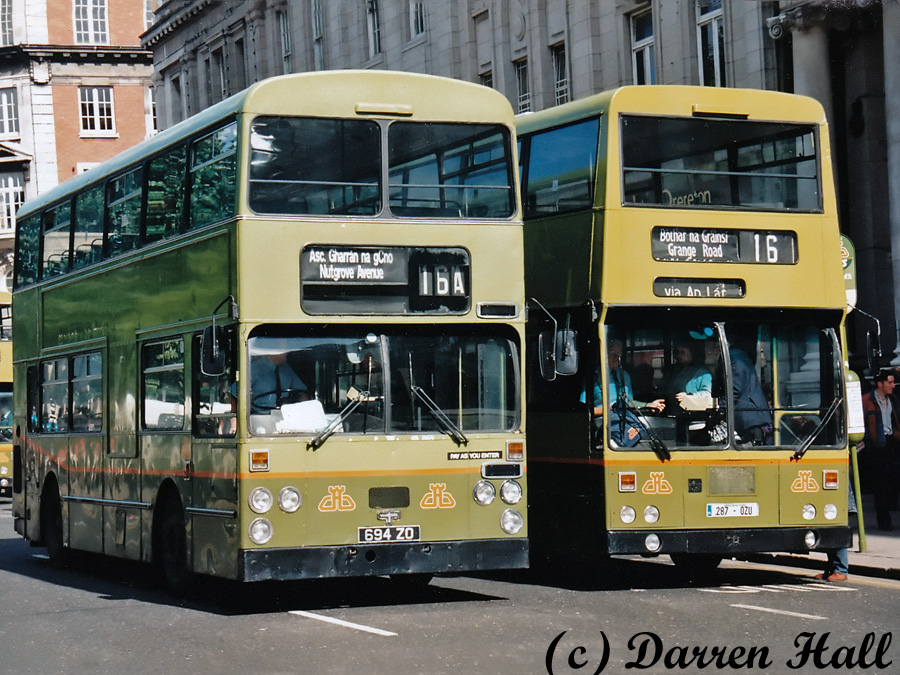
Van Hool-bodied Leyland Atlantean, D694, is seen operating Route 16A to Nutgrove Avenue passing Bombardier, KD287, operating Route 16 on O'Connell Street on the 10th July 1994. D694 was interesting in that Van Hool McArdle sent it as a Demonstrator to England. It visited Southampton, Portsmouth and Brighton on the south coast, though this didn't result in any orders. This bus was acquired by the National Transport Museum upon its withdrawal in 1995 and is part of their collection. KD287 also spent its entire career in Summerhill. Delivered in December 1982, KD287 was an incredible workhorse, and this author has many memories of it on the 16s and 20B. It lasted into the Millenium being withdrawn from service very early in 2000.
The 16, and its counterpart Route 16A, are cross city routes most associated with areas of Santry, Beaumont, Whitehall, Drumcondra, Harold's Corss, Terenure and Rathfarnham. This feature looks back at the history of these routes, along with the vehicles that have operated them over the past 20years. It is timed to correspond with the withdrawal of Route 16A on the 12th May 2012, another loss in the Network Direct Plan. The new amalgamated Route 16 will see buses operating from the 16A's northern terminus of Dublin Airport to the 16's southern terminus of Ballinteer.
Drumcondra was the first seciton of the route to get a tramway service. It was run by the North Dublin Street tramways. Drumcondra was up until the late 19th Century a very rural place, an amazing thought given its proximity to what would be considered the centre of Dublin. However, like many cities around the world it was quite cramped. It the 1870's significant development occurred in the area, however much of the land was still in the possession of the religious orders meaning that the catchment area of the tram was somewhat limited.
The name Drumcondra comes from the Irish "Droim Conrach", which translates as "Ridge of the Condraighe". The Condraighe were a local tribe, and the ridge refers to rising land north of the River Tolka. Drumcondra initially referred only to the village on the banks of the Tolka, however in time it would be used as the name of the lands around the village. The area had originally been referred to as Clonturk.
The first trams rolled into Drumcondra in March 1877. Two routes appear to have been taken by the trams, one via Capel Street to College Green, the other via Parnell Square to Nelson's Pillar. The Capel Street tram service wasn't so successful, being withdrawn in 1918 (though briefly reinstated due to the reconstruction of the Four Courts in 1922). The 71 bus route would eventually replace this service.
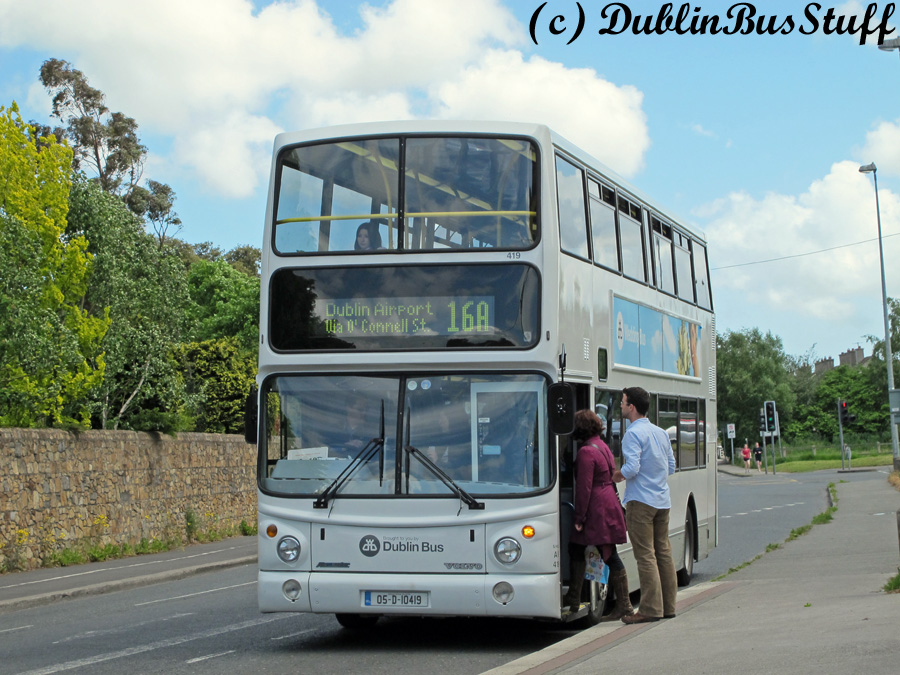
Summerhill's Wedding Liveried Alexander ALX-400 bodied Volvo B7TL, AV419, is seen on Grange Road Rathfarnham heading towards Dublin Airport on the 8th May 2011. Delivered in the summer of 2005, AV419 was one of two wedding buses delivered to Summerhill along with AV418. Clontarf received AV416 and AV417 at the same time, also in Wedding livery, however these were repainted with the arrival of EV88 and EV89. Being now 7 years old, AV419 would be considered old for a Wedding Bus by modern standards. Equipped with luggage racks it is more often to be found on Route 16A.
The Parnell Square service is the one most associated with the 16 service. Its exact routing was as follows:
Nelson's Pillar, O'Connell Street, Parnell Square East, North Frederick Street, Dorset Street Lower, Drumcondra Road Lower (terminus at Corner of Botanic Avenue).
The NDST's Depot was in Phibsborough (at the Tramway end of Dalymount Park), though was known as Cabra.
The areas of Harold's Cross and Rathfarnham were served by the Dublin Central Tramways Company with Terenure being served en route. The origin of the name Harold's Cross is often attributed to the Harold family who owned lands in the surrounding areas in the 14th Century, and that a stone cross at this point marked the boundary of their property. The Harold's welcomed the arrival of the British and became defenders of the pale.
Terenure comes from the Irish Tír an Iúir, meaning "land of the yew tree", this being the medieval name of the area. However, at the time of the tramways arrival the town was referred to as Roundtown, supposedly named after a group of houses near the crossroads that were arranged in a circle.
Rathfarnham lies about 1.2km south of Terenure. It literally translates from the Irish "Ráth Fearnáin", meaning Fearnain's Ringfort. However there is no reference to anyone named Fearnain in the area, and no artefacts from such a prehistoric dwelling have ever been found in the area. The village of Rathfarnham would have been quite rural at the time of the tramways extensions, it being one of many towns to benefit from access to transport that allowed people to move out from the cramped city slums.
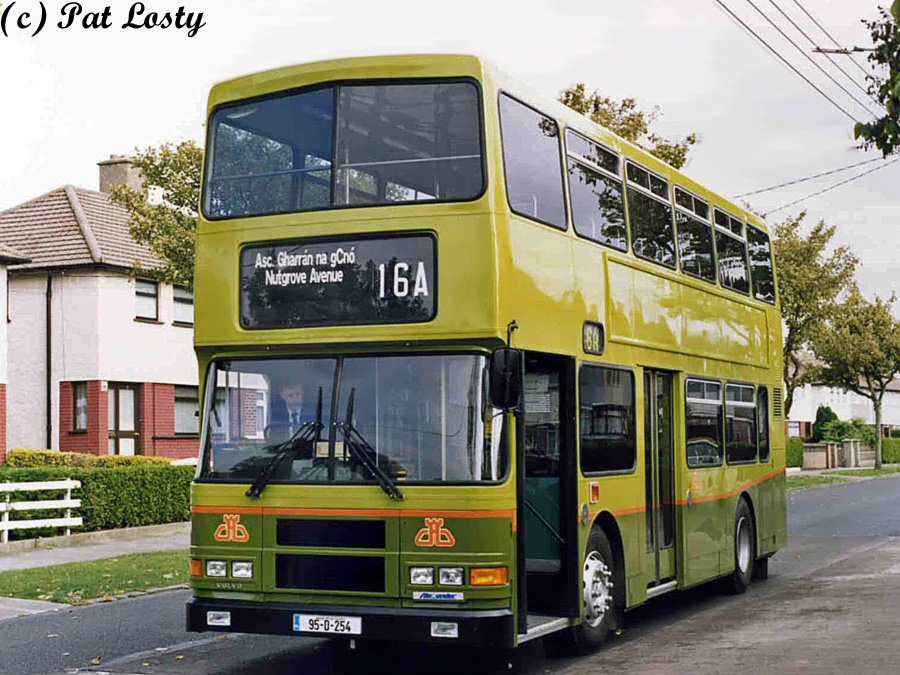
Alenxander R-bodied Volvo Olympian, RA254, is seen at the current 16 terminus on Shanard Road in September 1995. The 16A shared this terminus with Route 16 from the mid-80s to the late 90s. This bus was brand new at the time as depicted by the wonderfully clean wheeltrims. The RA class were not renamed until 1996, thus the 1994 and 1995 deliveries were actually RH designated first, being redesignated in 1996. RA254 was delivered to Summerhill along with RA242-RA255. The delivery of RV358-370 to Summerhill in 1997 saw RA254 cascaded to Donnybrook. RA254 would be repainted into CitySwift livery in the autumn of 1998 for use on Route 46A, being painted into the then core (Blue/Cream/Orange) in 2001 upon delivery of ALX400s for the corridor. RA254 was withdrawn in Donnybrook in 2007 upon the delivery of EV23-36. It was acquired by Stephensons, Essex and reregistered N827 FKK.
The line to Rathfarnham opened in sections. The first section was opened on the 1st June 1879, with trams running to Harold's Cross. The following day, on Whit Monday, 2nd June, trams were extended to Terenure (terminating at Garville Avenue). By the 14th June trams were running to the corner of Bushy Park Road. Finally on the 28th June 1879 the full line to Rathfarnham was opened. The exact routing was as follows:
College Green, Dame Street, South Great George's Street, Aungier Street, Redmond's Hill, Wexford Street, Camden Street Lower, Camden Street Upper, Harrington Street, South Circular Road, Clanbrassil Street Upper, Harold's Cross Road, Terenure Road North, Rathfarnham Road, Rathfarnham Main Street (terminating at corner of Church Lane).
A depot was built at Terenure (then Roundtown) to house the Horse Trams on the lands where Cormac Terrace now stands. The Dublin Central Tramways Company merged with the North Dublin Street Tramways Company and the larger Dublin Tramways company to form the Dublin United Tramways Company in 1880. One of the results of this was that after a few years (by 1883) the trams on the Rathfarnham line were extended to Nelson's Pillar.
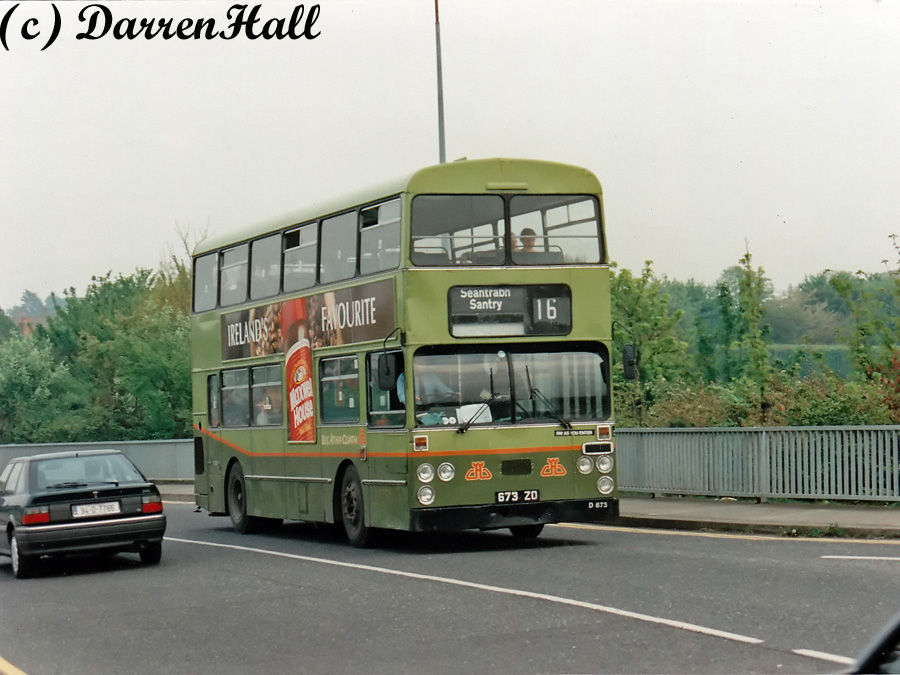
Van Hool-bodied Leyland Atlantean, D673, is seen operating Route 16 to Santry over the Shantalla Road flyover on the 11th May 1994. D673 is interesting in that it was withdrawn from service twice. Withdrawn in the Summer of 1992 with a number of other Van Hools upon the delivery of RH126-142, it and D616 were seperated from the rest of the withdrawn stock in Broadstone. This special treatment proved to be a great idea as a fire at Summerhill depot over the Christmas of 1992 which proved the end of KD84, KD285 and D707. D673 would trundle along until the Summer of 1995, ousted with the delivery of RA class vehicles.
The two lines were joined on the 9th November 1899, the line being converted to electric tram operation from that date. Electric traction offered significant financial savings over horse traction. Due to limitations of horses as living creatures, many horses were required to complete a full days service. Such a system also required a large amount of employees to care for them. Electric traction allowed trams to achieve higher efficiency in terms of operation speed (though the speed of the trams itself was limited by the authorities). Electric trams could just keep going, something that did not apply to the creatures that they replaced. With controls on both ends, trams didn't need to be turned around and thus could operate to a much tighter schedule.
It electric tram era that brought about the concept of cross city services, something which is now being introduced in large numbers with the new ongoing Network Review. The exact routing was as follows:
Drumcondra Road Lower (Corner of Botanic Avenue), Dorset Street Lower, North Frederick Street, Parnell Square East, O'Connell Street, Westmoreland Street, College Green, Dame Street, South Great George's Street, Aungier Street, Redmond's Hill, Wexford Street, Camden Street Lower, Camden Street Upper, Harrington Street, South Circular Road, Clanbrassil Street Upper, Harold's Cross Road, Terenure Road North, Rathfarnham Road, Rathfarnham Main Street (terminating at corner of Church Lane).
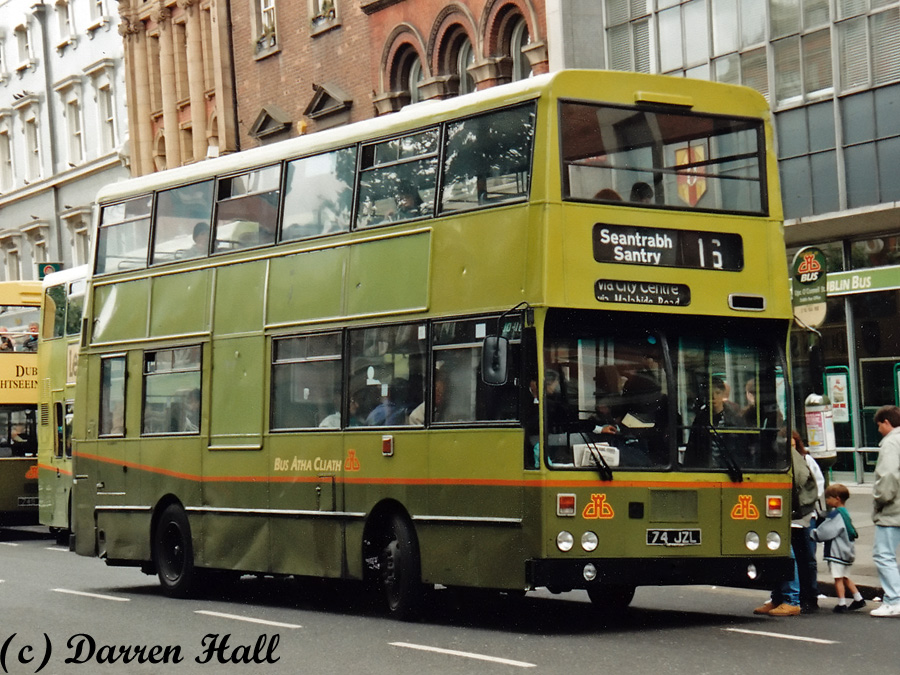
Bombardier double-decker, KD74, is seen operating a northbound Route 16 service to Santry on O'Connell Street on the 17th June 1995. Delivered to Summerhill as part of its first batch of Bombardier vehicles, KD71-91, in December 1981, KD74 went on to operate in Summerhill for a further 15 and a half years, being withdrawn in the early summer of 1997.
The General Secretary of the DUTC, R.S. Tresilian, went about detailing each of the lines after the electrification of the network had been completed. This was published in 1902 entitled "A Guide to Dublin and Suburbs". It is quite interesting, each line been described by a constant stream of consciousness, all without full stops. Reprinted in 1907 to correspond with the World's Fair in Dublin from which I quote:
"Rathfarnham to Drumcondra: Distance 6 miles, Cars run every 10 minutes –
This is another route similar to the two preceding (referring to the Phoenix Park-Donnybrook and Glasnevin to Dolphin's Barn services. Ed.) in that its starting and terminating points are at opposite sides of the city.
The cars start from the village of Rathfarnham, and pass along Rathfarnham Road, Rathfarnham Castle being on the right, crossing the very picturesque River Dodder, and at Terenure meet the lines of Route No. 3 (the number used in this guide to describe the Nelson's Pillar to Terenure via Rathgar line. Ed.), but proceed thence by a different route along Harold's Cross Road, by Harold's Cross, the Mount Jerome Cemetary bing on the left, to Clanbrassil Brisge, where they enter the city, along Clanbrassil Street, at the end of which they turn onto South Circular Road and hence through Camden Street and Aungier Street, from which by Lower Kevin Street St. Patrick's Cathedral can be readily reached, to George's Street, passing the South City Markets on the right, from which they turn into Dame Street, the Chamber of Commerce being on the left, into College Green, the Bank of Ireland and Royal Bank being on the left, and the statue of King William III between the lines in the centre of the roadway; past the statue of Grattan and Trinity College, passing through Westmoreland Street, where at the corner of D'olier and Westmoreland Streets, is the statue of Smith O'Brien; crossing O'Connell, formerly Carlisle, Bridge, they enter Lower Sackville Street, in which statues are erected in memory of Sir John Gray, the originator of the Vartry water supply to Dublin, and Of Daniel O'Connell, "The Liberator", this latter being the work of the great Irish sculptor, Foley; passing Nelson's Pillar they proceed along Upper Sackville Street, with the offices of the company, and further up the Gresham and Hammam Hotels on the right, and at the end of this street the Rotunda Hospital and the Assembly Rooms on the left, and along Rutland Square, Frederick Street, where they branch off into Dorset Street, and passing through this street over the Canal Bridge, follow the Drumcondra Road, the Roman Catholic Archbishop's Palace being on the right, to the Tolka Bridge, where they stop."
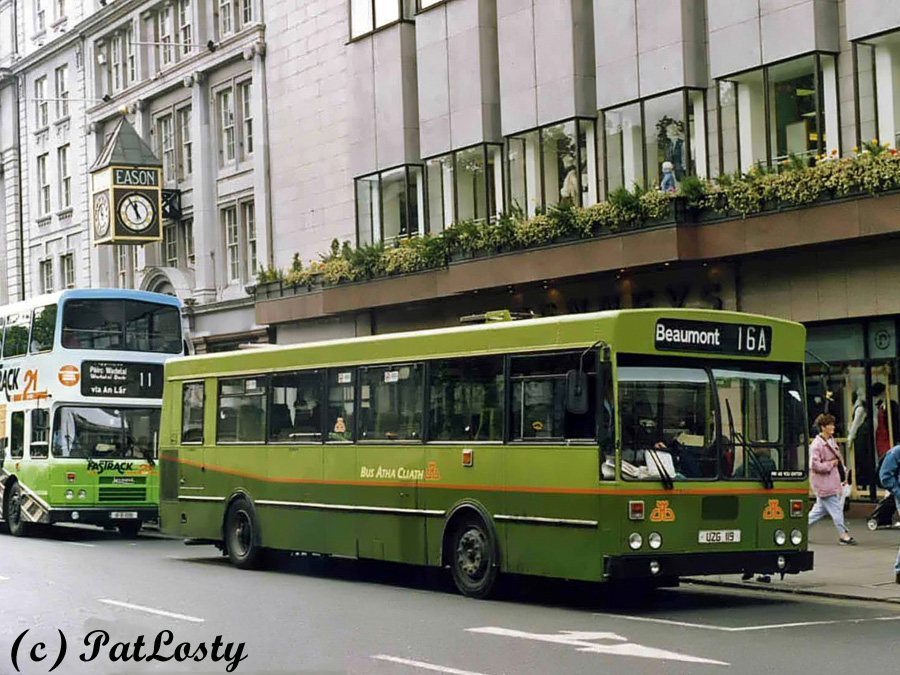
GAC single decker, KC119, is seen operating a northbound Route 16A service to Santry in August 1995. The display shows Beaumont, which was quite common at the time, however the Beaumont terminus had been vacated a full 10 years previously. KC119 entered service in Summerhill during the summer of 1985, on a new Dublin Airport service, having previously been stored in Donnybrook upon delivery. It was one of the buses to appear in an Aer Lingus livery in 1988 which it kept for about 2 years. Though delivered in dual door format, it was converted into single door format for use on this Airport service. The delivery of the Airlink ADs ousted KC119 from this service in 1994 and it was repainted in the standard two tone green livery. It also reverted back to Dual Door format. It was one of the final four KCs in the Dublin Bus Fleet, with Summerhill holding onto it until December 2000, the last month of KC operation.
The Rathfarnham line was run as two services. Drumcondra to Terenure was the core of the line and only half of the trams continued beyond this point to serve Rathfarnham. The Rathfarnham cars were roughly every 10mins, with cars also starting from Terenure also every 10mins giving a 5min headway on the service.
As noted before the area of Drumcondra was served by two tram lines, by the Drumcondra to Rathfarnham Line and the Drumcondra to College Green via Capel Street line. On the 7th September 1903, the tramway line was extended northwards of Drumcondra to Whitehall. Whitehall as a district name doesn't derive from any ancient Irish Name but instead refers to a manor house that was located where the Garda Station is today. It was very rural, Griffith Avenue wasn't built, though there was some development around the Home Farm Road. In what would differ to the stance of CIE's bus provision over the years, the tram actually preceded the development of the area it served. However, with access to a reliable form of transportation the development followed.
It was the service from College Green via Capel Street that was first extended to Whitehall, the Rathfarnham service continuing to serve only until Drumcondra. Given the line was single over much of its length it made sense not to send too many trams northwards of Drumcondra. However at some point in the early to mid 1910s (unfortunately due to lack of timetables in the period I could only date this to after 1910 and before 1917) the Capel Street service was cut short to Drumcondra.
From this time the Terenure to Drumcondra service was extended to Whitehall. Thus the service operated as two roughly eqi-distant services, one heading further north, the other further south, and the base frequency on the core section of Drumcondra-Terenure being twice the frequency of either of the Rathfarnham and Whitehall sections.
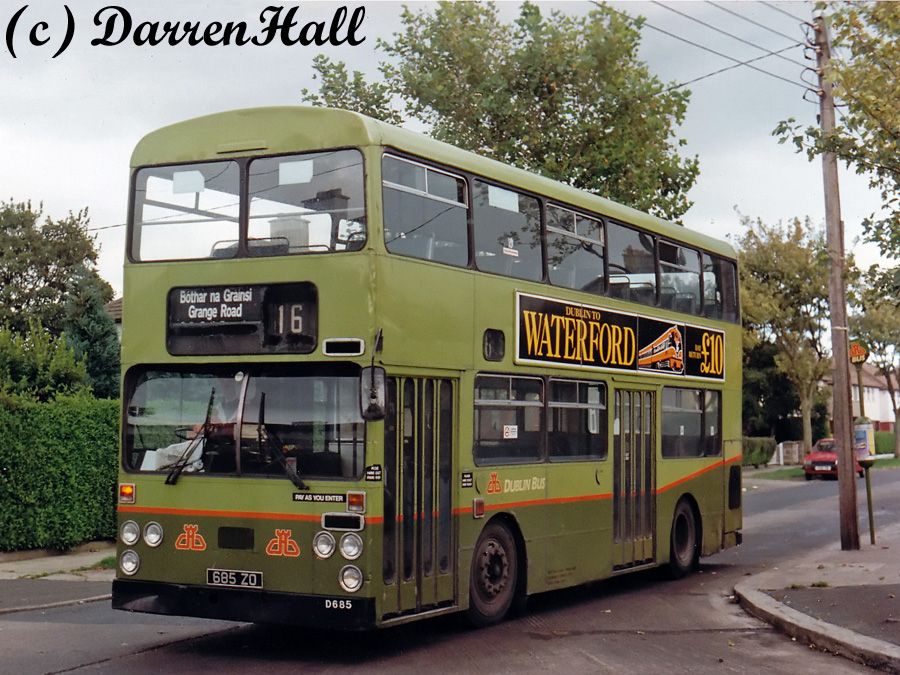
Van-Hool bodied Leyland AN68, D685, is seen operating Route 16 having just departed its Shanard Road terminus (stop behind) on the 23th December 1994. D685 was delivered to CIE early in 1978, and would go on to have a long operation history in Summerhill Garage. It soldiered on till the end of Summer 1995, the only blistering hot summer in this author's lifetime, when it was withdrawn and kept at the BMS Inchicore. Its replacement came in the form of RA242-8 delivered to Summerhill. It returned as an open-top sightseeing tour bus for the 1996 season, finally being withdrawn in the Summer of 2002, again replaced by RA-class buses.
Route numbers were actually not conceived until roughly 50 years after the dawn of tramway services. In the horse tram era the trams carried large lettering on their sides indicating their destinations and via points. With electric traction, came destination scrolls. However the DUTC, conscious of the high illiteracy rates in the city, decided to use a series of symbols to describe each of the lines. The Rathfarnham line was assigned a green Maltese Cross, and this symbol was displayed above the destination scrolls.
By 1918, with decreasing illiteracy rates, it was decided to do away with the symbol designations, replacing them with numbers. Each tram line was numbered in a clockwise series starting from Sandymount in the south east of the city. Thus the two Rathfarnham services were assigned the numbers 16 and 17. Route 16 designated trams heading from Whitehall to Terenure, while Route 17 designated trams heading from Drumcondra to Rathfarnham.
The Whitehall line was made double track in and around 1930, which saw Drumcondra being vacated as a terminus. The 11 which had terminated in Drumcondra since 1919 and the 17 were extended further northwards to Whitehall. It seems that around this this point the designation of the route numbers changed, with the 16 being used for the whole line from Whitehall to Rathfarnham, with Route 17 being used for shorts. Some of the literature from the time may suggest that the 17 did not exist for a short period, with 16 seemingly denoting the Whitehall to Terenure shorts as well as the main Whitehall to Rathfarnham services, however it is not known whether this was the case in practice. However by the mid-to-late 1930s, the designations of Route 16 and 17 were as noted above.
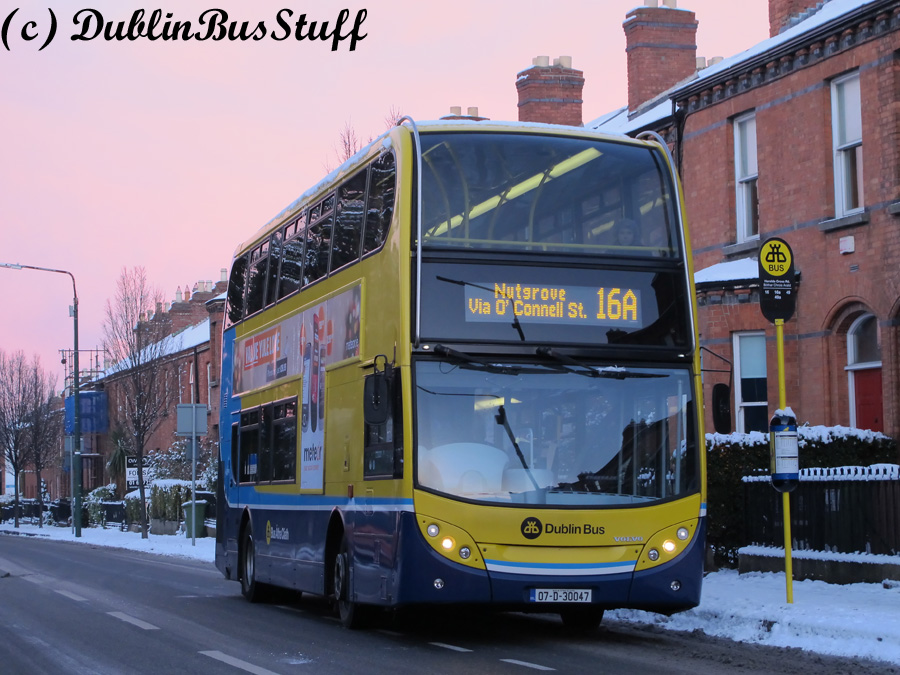
Enviro-400 bodied Volvo B9TL, EV47, is seen on the Harold's Cross Road on Route 16A on the 28th November 2010. The redness of the sky is no photoshop modification, I recall this night very vividly, as snow during the day and electrical storms at night is generally quite rare in this fair city. Still made for an interesting sky. EV47 was delivered to Harristown garage in October 2007, remaining there for three years, before transferring over to Summerhill garage not long before this photo was taken for use on the new 'Network Direct'ed Route 123. EV47 has just passed Harold's Cross, so the driver can take it easy till his next run. The 16A has always been joyfully known as "Nailed to the Cross", a reference to its general loadings between the Airport and Harold's Cross, which made the 16A one of the best used services in the city. I'm sure this term will continue to be used, but now for the 16 itself.
The Whitehall double tracking is quite interesting in that it underlines an important point in the short sightedness of governmental departments associated with transport in the city. Double tracking of the Whitehall line was completed except for sections close to its terminus at Griffith Avenue and at the Cat & Cage Pub on the Drumcondra Road Upper.
At this pub the roadway narrowed and thus was not wide enough for two tracks. However at the northern end of the single line section the DUTC installed a turnout, instead of simply splitting the tracks. For us bus enthusiasts who don't know what a turnout is see here. The engineers at the time envisaged that the roadway would someday be widened, removing the aforementioned bottleneck. Over 80 years on and this bottleneck still exists, with buses continually delayed by large traffic tailbacks and the inability for bus lanes to be provided.
The 1920s and 30s were a period of expanding suburbs in Dublin. The company decided in 1925 to begin operation of buses. This was a significant step, however the reopening of the Lucan Line and the new Luxury Car fleet of the early 1930s showed that tramways were very much part of the company's future plans. This was set in a backdrop of ever decreasing tramway systems in the British Isles. Cork for example replaced its trams with double-deck buses in 1931.
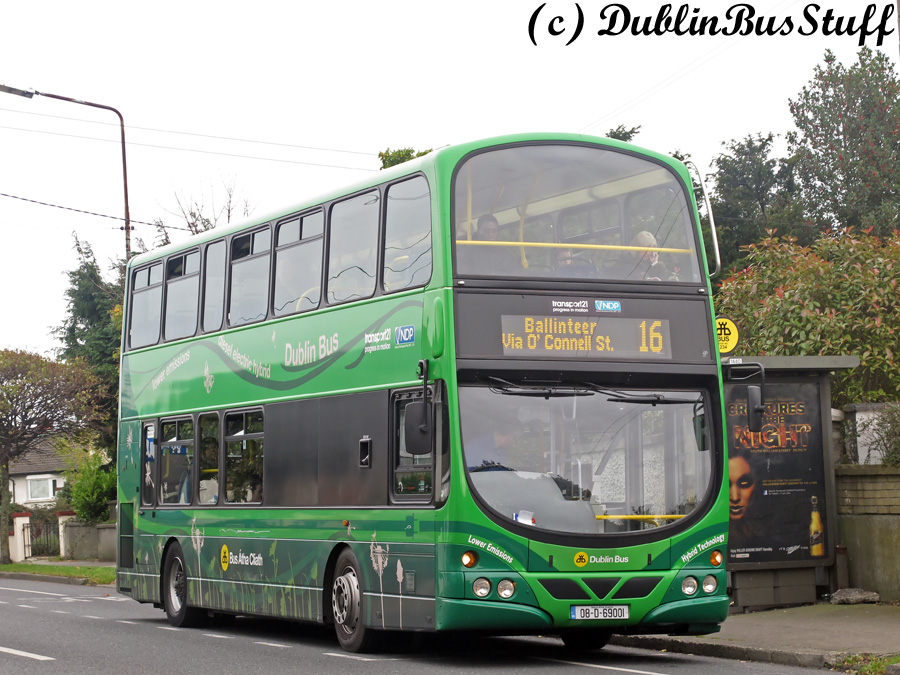
Wright Pulsar Gemini bodied Ford engined VDL DB250 hybrid bus, WH1, is seen on the Beaumont Road operating Route 16 on the 22nd December 2011, soon before its ultimate withdrawal from the fleet. It entered service in late December 2008, so having lasted only 3 years in service makes it the shortest lifed vehicle type ever in the Dublin Bus fleet. The fact it spent much of this time off the road doesn't make its time here any better. However it was an enigma and I do miss chasing it. It went to the UK and has started a new career for itself with Ensign, Purfleet, and has made it into active service there.
However in terms of extensions to the network, it was all in the form of bus routes. Thus the writing was on the wall. Bus transport had significant advantages over tramway. First of all it was cheaper to provide. The tramway company were forced to pay for the upkeep of their permanent way, whereas this was not necessary for bus companies. This permanent way also removed the flexibility that buses had in terms of routing or extensions to new estates. The one advantage that the tram had was that it could carry significantly more, especially given the DUTC had an all single-decker fleet in the early to mid 1930s, and the double deckers available were small in comparison to the tram.
However the arrival of Leyland Titan TD4s R1 and R2 in December 1937 was the death knell for the tramway network. The TD4 was the fourth generation of a successful line of double-deck buses built by the Leyland company since 1927. Being the 4th generation it was a much more refined machine than earlier double-deck types.
It was no doubt seen as the way forward. The company waited a few months before finally committing, though most likely just announcing something which had previously been decided, that the tramway system would be replaced by a large fleet of double-deck buses. This announcement was made when the DUTC board met on the 1st March 1938, no doubt happy enough with the performance of R1 and R2 to see the double deck bus as the ultimate successor to the much loved tram system.
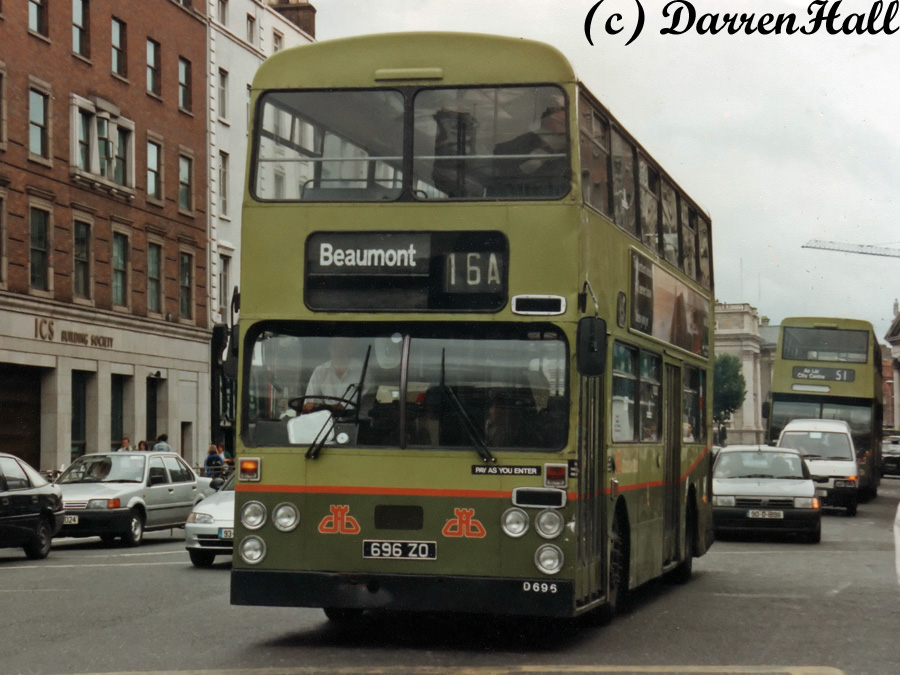
Van Hool-bodied Leyland Atlantean, DF696, is seen operating Route 16A to Santry on Westmoreland Street on the 12th August 1995. Just like KC119 above, DF696 is also displaying the incorrect Beaumont display for Route 16A, however a number of these D's trundled up and down on the 16s and 20B never showing anything other than Beaumont for days at a time. New in 1975 to Summerhill it became DF696 early in 1991 courtest of then withdrawn DF470. It lasted till the the delivery of the RA class in Summerhill in the autumn of 1995, seeing further service as an open top vehicle in the summer of 1996 on an expanded City Tours service. It lasted until 2002, again ousted by RA class vehicles.
The Whitehall-Rathfarnham via Harold's Cross line was withdrawn on the 31st April 1939, along with the northern end of Route 11 which shared its routing from Nelson Pillar northwards. Buses began operation on Routes 16 and 17 on the 1st May 1939. This time the 17 became the full route from Whitehall to Rathfarnham, whereas the 16 was a short from Whitehall to Terenure. Both routes were extended further up the Swords Road to a roundabout at the junction of the Swords Road and Collins Avenue. Exact routing was as follows:
Route 16: Swords Road (Roundabout at Collins Avenue), Swords Road, Drumcondra Road Upper, Drumcondra Road Lower, Dorset Street Lower, North Frederick Street, Parnell Square East, O'Connell Street, Westmoreland Street, College Green, Dame Street, South Great George's Street, Aungier Street, Redmond's Hill, Wexford Street, Camden Street Lower, Camden Street Upper, Harrington Street, South Circular Road, Clanbrassil Street Upper, Harold's Cross Road, Terenure Road North, Templeogue Road, Fergus Road (returning via Rathfarnham Road).
Route 17: Swords Road (Roundabout at Collins Avenue), Swords Road, Drumcondra Road Upper, Drumcondra Road Lower, Dorset Street Lower, North Frederick Street, Parnell Square East, O'Connell Street, Westmoreland Street, College Green, Dame Street, South Great George's Street, Aungier Street, Redmond's Hill, Wexford Street, Camden Street Lower, Camden Street Upper, Harrington Street, South Circular Road, Clanbrassil Street Upper, Harold's Cross Road, Terenure Road North, Rathfarnham Road, Rathfarnham Main Street (terminating at corner of Church Lane).
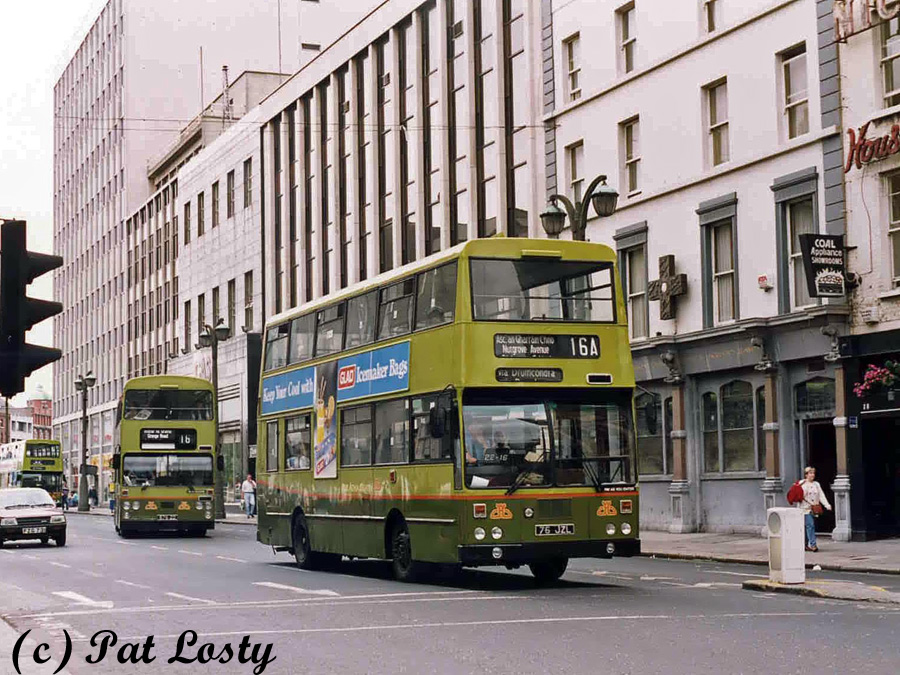
Bombardier KD76 is seen operating Route 16A to Nutgrove Avenue on D'olier St in August 1991, with D675 seen operating Route 16 behind. Delivered to Summerhill as part of its first batch of Bombardier vehicles, KD71-91, in December 1981, KD74 went on to operate in Summerhill for a further 16 years before being transferred to Ringsend along with KD72 in the early part of 1998. It would spend a year or so there before its eventual withdrawal.
1951 saw much of the tram lines around the College Green area of Dublin removed. This involved a significant amount of road works and lead to the diversion of buses for a number of months. Interestingly, most of the diversions affected routes only in one direction, as generally only one side of a road was closed.
For the 16 and 17, with College Green closed to traffic southbound, they travelled via O'Connell Street, Bachelor's Walk, Ormond Quay Lower, Grattan Bridge, Parliament Street, Dame Street, South Great George's Street. This change was effective from the 20th April 1951. Buses heading northbound were unaffected.
On the 5th June this was reversed, this time buses southbound being unaffected, with buses travelling the reverse of the diversions noted above, again serving the Northern Quays. From the 5th July works were complete and the routes returned to their normal routings.
Further expansion in their outer areas of Rathfarnham and Whitehall saw a rather bizarre change, well in a bus sense. In late 1954 (November or December), the 16 was cancelled and all buses became Route 17 services. The 16 had constituted about half the services on the corridor, however the 17 timetable never changed to account for this severe reduction in service. It seems obvious that more 17s were running.
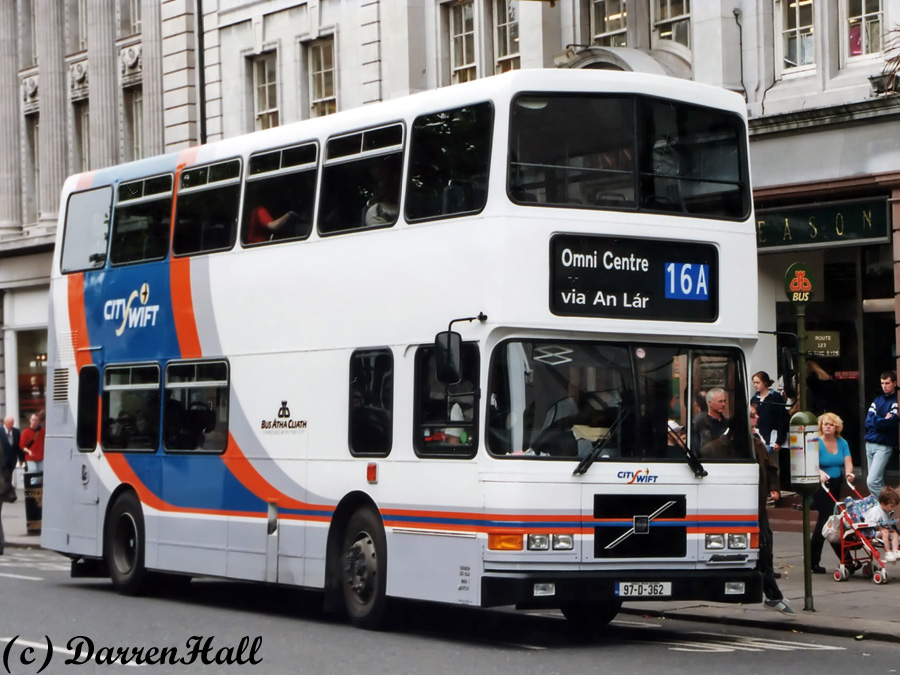
RV362 is seen operating a 16A service to the Omni Centre on O'Connell Street on the 6th September 1997. Less than a month in service when this photo was taken, RV362 was part of a large batch of RV buses, 358-370, which ousted RH class buses to Clontarf and RA buses to Phibsborough and Donnybrook. The blue blinds were unique to this batch, being an experiment that eventually resulted in the yellow on black "dayglo" blinds. It moved to Harristown upon its opening at the end of October 2004, and was withdrawn late in 2008 upon the delivery of EV65-74 there.
Then on the 5th April 1955 the 16 returned, along with a new 16A service running in conjunction with Route 17. The roundabout at Whitehall had gone by this stage and the 17 turned right off the Swords Road onto Collins Avenue West, performing a reverse manoeuvre at the corner of Thatch Road. The new 16 ran from Santry to Grange Road, whereas the 16A ran from Beaumont to Lower Rathfarnham. The exact routings were as follows:
Route 16: Santry (Corner of Shanliss /Shanowen Roads), Shanowen Road, Swords Road, Drumcondra Road Upper, Drumcondra Road Lower, Dorset Street Lower, North Frederick Street, Parnell Square East, O'Connell Street, Westmoreland Street, College Green, Dame Street, South Great George's Street, Aungier Street, Redmond's Hill, Wexford Street, Camden Street Lower, Camden Street Upper, Harrington Street, South Circular Road, Clanbrassil Street Upper, Harold's Cross Road, Terenure Road North, Rathfarnham Road, Rathfarnham Main Street (noting of course that the Rathfarnham Village bypass did not exist), Grange Road (terminating at the corner of Sarah Curran Avenue).
Route 16A: Beaumont (Coolatree Road), Beaumont Road, Collins Avenue West, Swords Road, Drumcondra Road Upper, Drumcondra Road Lower, Dorset Street Lower, North Frederick Street, Parnell Square East, O'Connell Street, Westmoreland Street, College Green, Dame Street, South Great George's Street, Aungier Street, Redmond's Hill, Wexford Street, Camden Street Lower, Camden Street Upper, Harrington Street, South Circular Road, Clanbrassil Street Upper, Harold's Cross Road, Terenure Road North, Rathfarnham Road, Rathfarnham Main Street (noting of course that the Rathfarnham Village bypass did not exist), Grange Road, Nutgrove Avenue (terminating at Corner of Loretto Row).
Hardwicke Street is long associated with the 16 and 17 routes. The first record of these routes operating via Hardwicke Street is on and from the 3rd February 1953, with services operating via Hardwicke Street and Place in both directions between North Frederick Street and Dorset Street. This was only a temporary diversion due to roadworks on Dorset Street. It is likely that buses stopped using this street after the roadworks, not returning for a number of years due to the large redevelopment on the street in the mid-50s. Therefore from about the late-1950s to about the mid-1970s Hardwicke Street was used by the 16 and 17 services inbound between Dorset Street Lower and North Frederick Street.
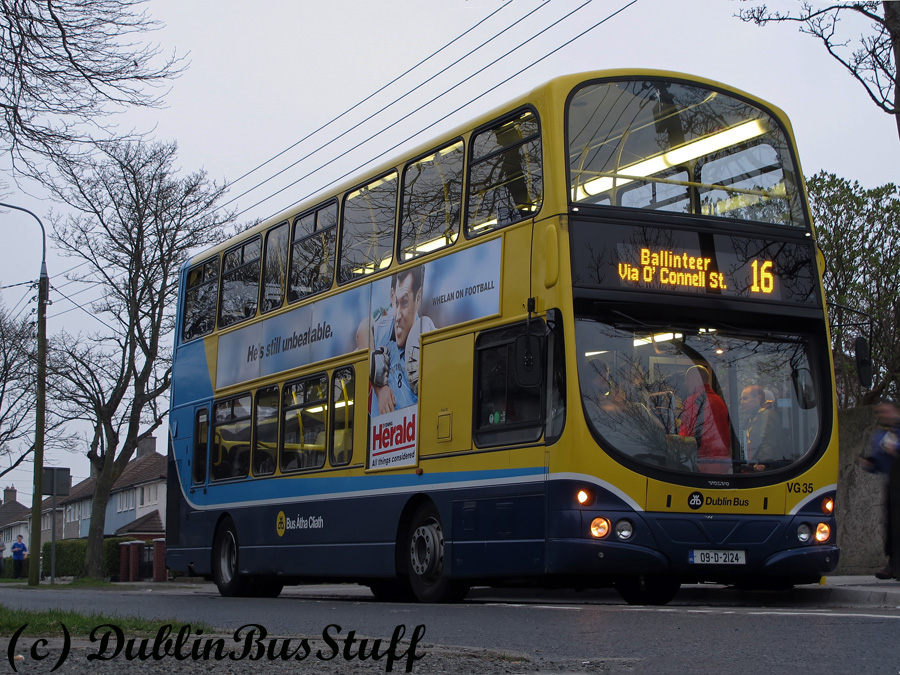
Wright Gemini bodied Volvo B9TL, VG35, is seen at the Shanard Road terminus of Route 16 on the 26th March 2011. Delivered to Summerhill early in 2009, VG35 is one of only two VG class buses in Summerhill that do not have luggage racks.
The 17 was reduced to a peak hour only service a few years later in March/April 1957, with the 16s correspondingly increased in frequency. The 17 was reduced to a peak hour only service a few years later in March/April 1957, with the 16s correspondingly increased in frequency. The 16 was moved to its current terminus in June 1957. However instead of returning via Shanliss Road as is the current arrangement, the buses performed a reverse manoeuver at the corner with Shanard Avenue and returned via Shanard Road, Shanliss Road to Swords Road.
The next change was the 16A being withdrawn from its terminus at Coolatree Road and moved to a new terminus on Shanboley Road in April/May 1960. The exact routing in the Beaumont area was as follows:Collins Avenue West, Beaumont Road, Shantalla Road, Shanboley Road, Shantalla Avenue, Shantalla Road, Beaumont Road, Collins Avenue West.
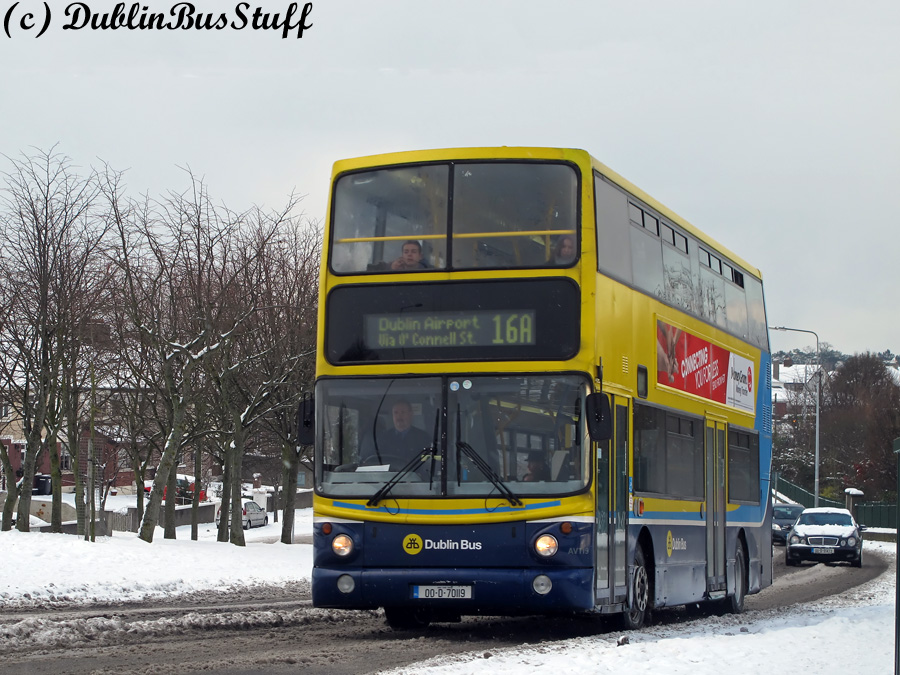
Dual-doored Alexander ALX400 bodied B7TL, AV119, is seen operating a Route 16A service to Dublin Airport on an icy Shantall Road flyover on the 23rd December 2010. AV116-130 were delivered as dual door for use on the 747/748 services. This batch of vehicles is topical at present given that they were the last delivered to Dublin Bus with two doors, something which had been standard for double deckers since the 1960s. However, union issues meant that dual door operation was never implemented in Dublin. The lastest vehicle type to Dublin, the GT class with delivery in the next few months, will also have dual doors, though I'm hopefull that we will see these vehicles used as intended. The delivery of AV116-129 ousted Volvo Olympians RV513/RV514/RV515/RV516/RV639/RV640 and DAF SB220/Alexander Setanta AD35/AD36/AD37/AD38/AD39/AD40/AD69/AD70 from the Airlink service to standard service. They themselves were repainted and ousted from the Airlink service upon the delivery of the Airlink VGs, VG36-48, in early 2009.
Also around this time the 16A was extened up Nutgrove Avenue to its current terminus at the Bottle Tower. These termini arrangements lasted a number of years, but by 1964 the 16 was operating the one way loop in currently does, namely:
Swords Road, Shanowen Road, Shanliss Road, Shanard Road, Shanard Avenue, Shanliss Road, Shanowen Road, Swords Road.
The 16A was also modified to terminate further up Shanboley Road, a terminus it would then remain at for the next 20 years. The routing was as follows:
Collins Avenue West, Beaumont Road, Shantalla Road, Shantalla Avenue, Shanboley Road, Coolgarrif Road, Shantalla Road, Beaumont Road, Collins Avenue West.
As indicated the 17 was a peak hour extra service, however in 1962 the footnote in the 16 timetable indicating its existence was removed. However, it still operated, either as unscheduled short working or universals etc…
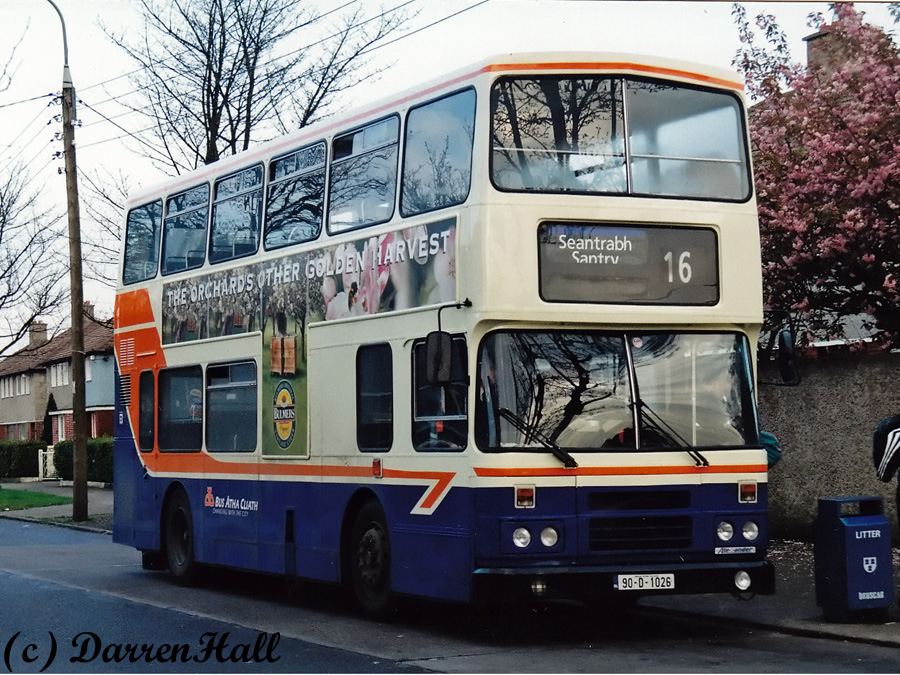
: Alexander R-bodied Leyland Olympian, is seen at the Shanard Road Santry terminus of Route 16 on the 23rd March 1998. Delivered late in 1990, RH24 was part of the first Olympian batch to Summerhill, comprising RH19-30. RH24 was withdrawn from service after just 11 and a half years in the Summer of 2002, a statement to the large fleet replacement programme funded by the then booming Celtic Tiger. It was acquired by Ensign, Purfleet, and went onto see further service with Isle of Mann transport.
In the 60s some of the traffic engineers in the city must have come across the manual for one way traffic. With ever worsening traffic conditions in the city, creating squares of one way roads did relieve traffic congestion at the major road junctions in the city. However back then, and to this day, the radical suggestion that cars should somehow be discouraged from entering the city centre has never been entertained. Hence Dublin, like many cities, has vast quantities of one way systems.
The first change to affect the 16 services was the conversion of Westmoreland Street/D'olier Street/College Street to a one way triangle on the 18th March 1964. The 16/16A/17 northbound routing was unaffected but the southbound routing changed to:
O'Connell Street, O'Connell Bridge, D'olier Street, College Street, College Green, Dame Street.
With this change proving successful, it was decided to make Parnell Square one-way prior to the Christmas shopping rush on the 16th December 1964, a precursor to the operation freeflow fiascos of the modern era, where cars are not requested to avoid the city centre, but are just told not to do anything bold. The flow around the Square was clockwise as per its present arrangement. This time the southbound routing of the 16/16A/17 was unaffected but the northbound routing became:
O'Connell Street, Parnell Street, Parnell Square West, Parnell Square North, North Frederick Street, Dorset Street Lower.
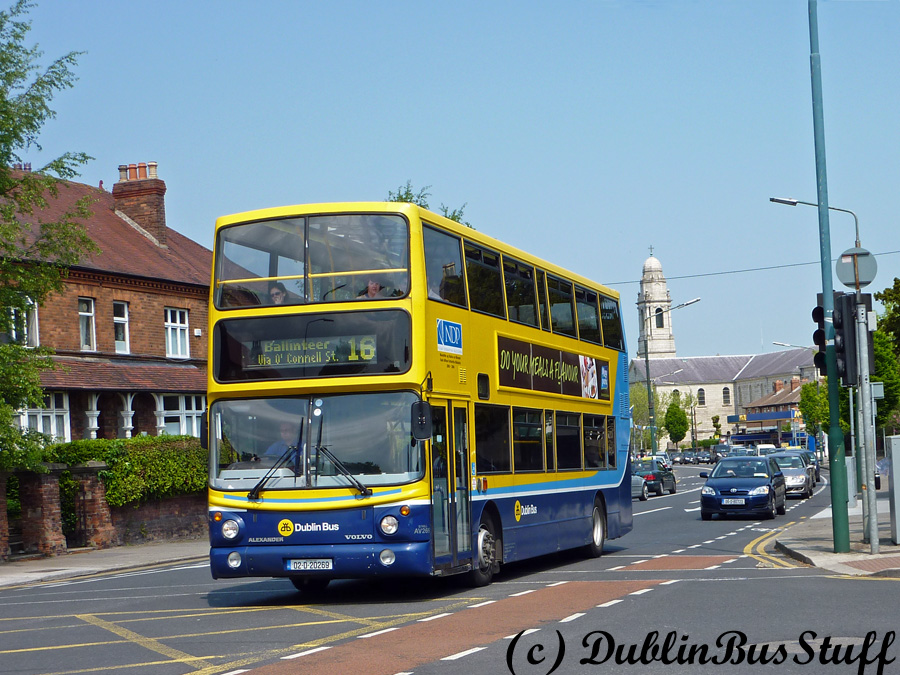
Alexander ALX400 bodied Volvo B7TL, AV269, is seen on the Harold's Cross Road on Route 16 on the 22nd May 2010. AV269 is part of small batch of AVs in Summerhill, AV266-273, though AV266 has been off service for some time since it was side swipped by a Luas on O'Connell Street while operating Route 16.
The very busy Harrington/Richmond/Harcourt/Camden Street junction was next to be changed. A one way system was created on the triangle created by Harcourt Road, Camden Street Upper and Charlotte Street on 25th May 1966. Charlotte Street is a road since removed by the construction of the Camden Court Hotel Complex in the early 90s. It ran from Camden Street Upper (where Charlotte Way is now) and ran in a straight line to line up with Charlemont Street. Charlotte Way at the time did not exist. At the Bleeding Horse Pub there was therefore a hairpin turn from Camden Street Upper onto Charlotte Street.
The 16/16A/17 southbound routing was unaffected, but the northbound became:
Camden Street Lower, Camden Street Upper, Charlotte Street, Harcourt Road, Harrington Street.
The roads leading onto Parnell Square namely Granby Road and North Frederick Street were made one way on the 29th October 1969. This was the final one-way change that affected the 16 routes, so the city centre routing in full at this time was:
Southbound: Dorset Street Lower, Hardwicke Place, Hardwicke Street, North Frederick Street, Parnell Square East, O'Connell Street, D'olier Street, College Street, College Green, Dame Street, South Great George's Street, Aungier Street, Redmond's Hill, Wexford Street, Camden Street Lower, Camden Street Upper, Charlotte Street, Harcourt Road, Harrington Street.
Northbound: Harrington Street, Camden Street Upper, Camden Street Lower, Wexford Street, Redmond's Hill, Aungier Street, South Great George's Street, Dame Street, College Green, Westmoreland Street, O'Connell Street, Parnell Street, Parnell Square West, Granby Road, Dorset Street Upper, Dorset Street Lower.

Van Hool-bodied Leyland Atlantean, D695, at the former Grange Road terminus of Route 16 on the corner of Sarah Curran Avenue on the 8th May 1995. This photo was taken only a few weeks before D695's withdrawal from service. Delivered in April 1975, D695 gave 20 years of tireless operation before being withdrawn early in June 1995 due to the transfer of the remaining Van Hools at Phibsborough, D830/D836/D837/D839/DF838, to Summerhill.
The 16 routes remained pretty much the same throughout the 1970s. The only notable differences was the removal of the Hardwick Street routing, buses reverting to turning left from Dorset Street to North Frederick Street inbound from the mid-1970s. Also notable was that up to the mid-to-late 1970s the Rathfarnham Road lead onto Rathfarnham Main Street, which then lead onto Grange Road.
It wasn't until the mid-to-late 1970s than the Rathfarnham Relief Road was built in front of Rathfarnham Castle, thus allowing Rathfarnham Bound traffic to divert away from the narrow Main Street. Though the road structure has changed here with the building of this relief road, the old alignment can still be made out. If you stand at the end of the main street, there is a road leading away at a 45 degree angle that is used for parking. This is the old alignment of the Main Street which bended at this point and continued straight ahead to meet up with the Grange Road.
When the relief road was first built the 16s continued to serve the Main Street. This involved turning off the Rathfarnham Road onto the Main Street, then onto the newly realigned Butterfield Avenue, which re-joined the new relief road and onto Grange Road. The same was performed in reverse on the return journey.
Prior to the early 1980s only a very narrow road linked the Lorcan Park estate with the Shanrath Road, on opposite sides of what's now the N1. This road was completely unsuitable for bus operation. However with the construction of the airport motorway in the 1980s came the Shantalla Flyover, which linked the Shantalla Road with the Swords Road directly.
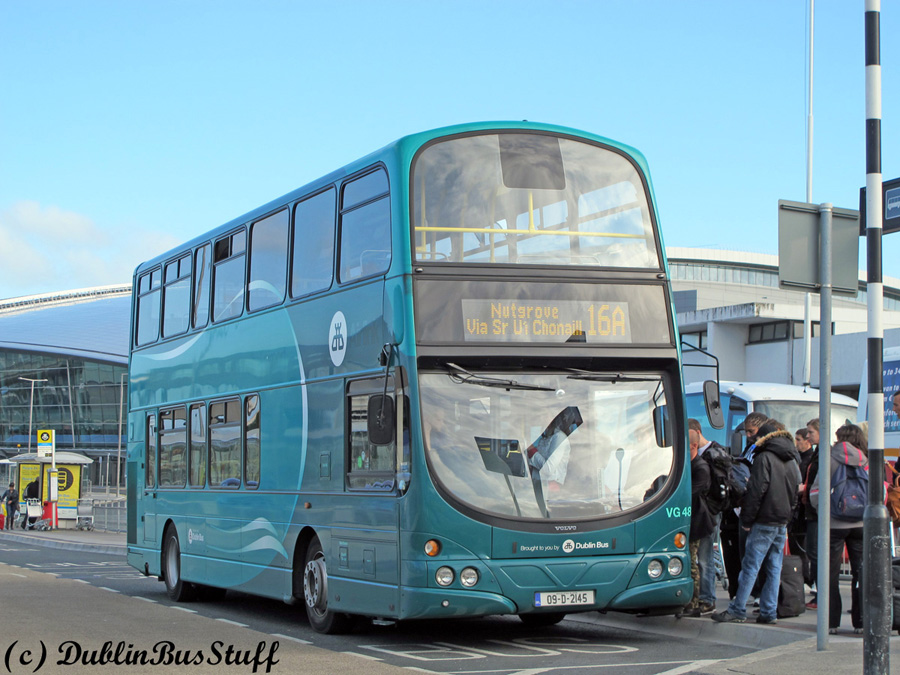
Wright Gemini bodied Volvo B9TL, VG48 is seen at the Dublin Airport terminus of Route 16A on the Atrium Road on the 8th May 2011. The curved roof of the new Terminal 2 is seen in the rear of the photo. VG48 was the last of the Airlink batch of VG class vehicles, VG36-48, which were equipped with large luggage racks and less seating downstairs. VG49 and 50 were also delivered in this format but as spare for the service, being given fleet standard livery for general use on standard city services. A new reduced Airlink timetable saw these buses lose their Airlink decals in November 2010, for use on standard services. These buses are due for a repaint soon, so the days of the Airlink-less buses will soon end. VG48 spends a lot of its time on the 16A due to its extra luggage racks, a bit of added comfort normally reserved for the premium Airlink paying customers.
A few years after this it was decided to merge the 16 and 16A routings northside, with all buses serving Santry via Beaumont, except for a few morning services which departed from Beaumont only. This change was implemented on the 19th May 1985. Another change was that buses no longer diverted via Rathfarnham Main Street but instead kept to the relief road. The exact Beaumont routing was as follows:
Swords Road, Collins Avenue West, Beaumont Road, Shantalla Road, Shantalla Flyover, Swords Road, Shanowen Road, Shanliss Road, Shanard Road, Shanard Avenue, Shanliss Road, Shanowen Road, Swords Road, Shantalla Flyover, Shantalla Road, Beaumont Road, Collins Avenue West, Swords Road.
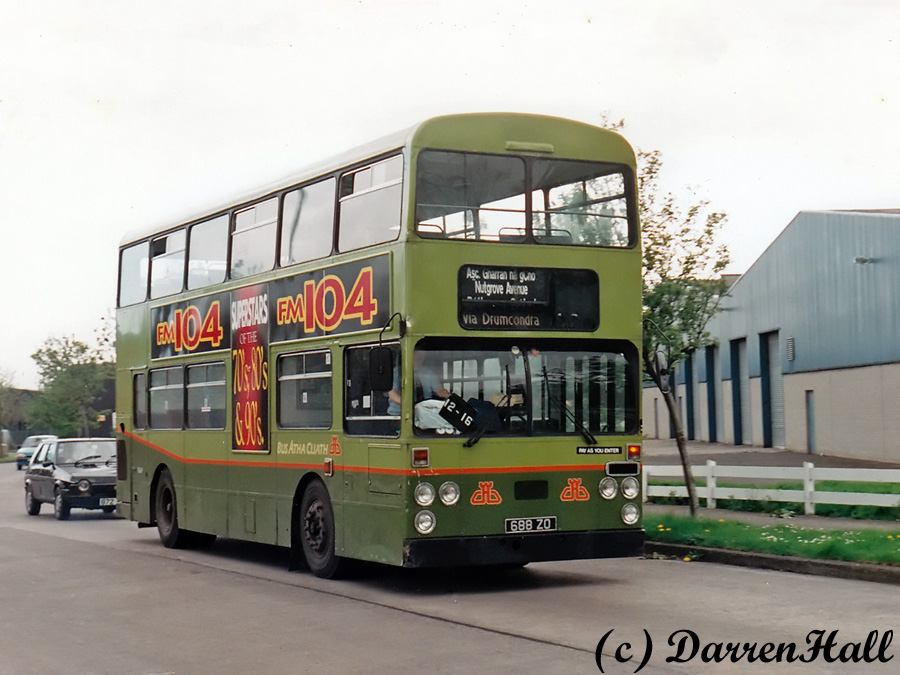
Van Hool bodied Leyland Atlantean, D688, is seen in Airways Industrial Estate on a service to Nutgrove Avenue in the early-90s. The lack of route number was not too unusual, with it generally being accepted in the Beaumont area that a bus lacking a number was on the 16s. This bus would have operated as a Route 16B service to Airways Industrial Estate. Delivered to Summerhill in May 1975 it lasted until October 1994 when the 36 moved to Summerhill with a subsequent influx of KC Class single deckers from Conyngham Road and Phibsborough.
The 16 was converted to One Person Operation on the 11th September 1988. The 16B also started then or relatively shortly after, and the services from Beaumont in the morning were dropped except for one service in the morning peak to the city only which lasted a few more years. The 16B was a peak hour only route to/from Airways Industrial Estate
It operated as a Route 16 or 16A from Grange Road or Lower Rathfarnham via the Beaumont Loop to the Swords Road but instead of turning into Santry it continued on the Swords Road to Airways Industrial Estate, turning right into Turnapin Lane, before using the square of roads formed by Constellation Road, Viscount Avenue, Boeing Road, Dakota Avenue to terminate and turn around, continuing back to Turnapin Lane and the Swords Road. Heading towards Airways buses displayed Route 16B, however heading in the opposite direction they displayed either Route 16 or 16A depending on which terminus they were heading to.
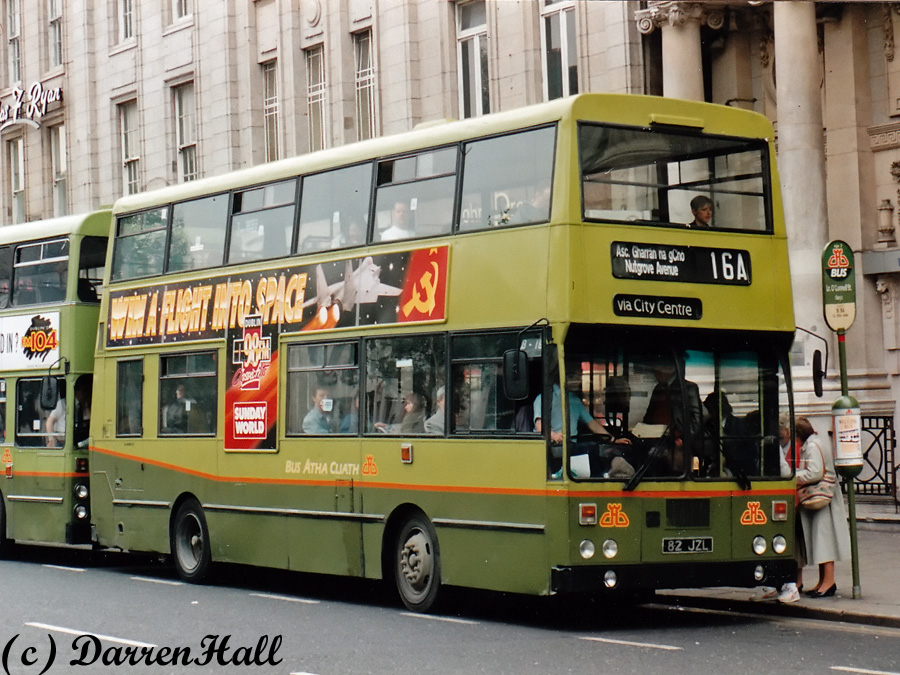
Bombardier double-decker, KD82, is seen operating Route 16A to Nutgrove Avenue on O'Connell Street on the 11th May 1994. Delivered to Summerhill as part of its first batch of Bombardier vehicles, KD71-91, in December 1981, it was cascaded from Summerhill early in 1997, spending a very short period in operational service in Phibsborough before being withdrawn from service.
The Omni Park Shopping Centre was one of a wave of shopping centres that opened in the early 1990s, as shopping moved from the city centre to retail outlets on the outskirts of the city. Located in Santry, the centre opened on the 25th October 1991. With their terminus located nearby it was decided to extend certain Route 16 and 16A services to the centre.
One bus every 20-30mins was diverted away from the Santry terminus to serve Omni Park, and it varied between 16 and 16A services. There was no Sunday service to the Omni Centre, as back then Sunday shopping was an alien concept. The terminus was located in the centre itself, and still exists even though no bus serves it now. The buses turned left off the Swords Road and terminated at a purpose built pull in on the left. Then when departing buses continued towards the end of the road and turned at a roundabout in front of the OmniPlex and exited the way they came in.
The imminent construction of the southern section of the M50 in 1999 meant that then current operation of Routes 47/A/B was unsustainable. In any case the routes were not efficiently set up, with much of their operational area in upper Rathfarnham being very rural, and their routing to the city around Rathmines being unique and very prone to large traffic issues. So as part of their withdrawal certain Route 16 services were extended to the Route 47B terminus at Marley Grange on the 27th June 1999, and numbered Route 16C. Services left from Santry/Omni Park, especially on Saturday and Sunday, however on a Monday to Friday about half departed from Parnell Square East only.
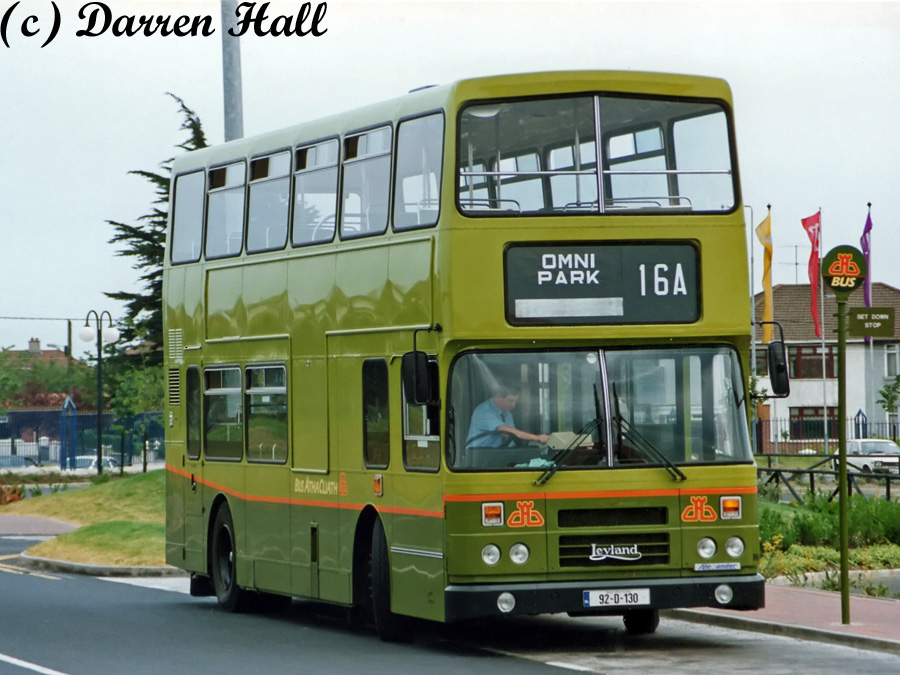
Alexander R-bodied Leyland Olympian is seen on a Route 16A service at the Omni Park terminus on the 26th June 1992. Delivered in February 1992. It was displaced from service with the arrival of AV418-429 to Summerhill in 2005, being converted for Open Top Tours service upon which it is still active.
There it shared the terminus with Route 47B until the 11th September 1999, when the 47 group of routes was withdrawn. Route 16C services continued past the Sarah Curran Avenue terminus of Route 16 on the Grange Road, following the turn in the Grange Road at Marlay Park and terminated at the corner of Grange Road and College Road. There there is a wide corner with Kellystown Road and the bus bay is still there.
On the 27th September 1999, a full range of Xpresso services were introduced. On this list was the 16X service but it never ran. It operated Route 16 from Santry to College Green, it then was to run as a 32X service to Belfield. Summerhill had real problems implementing Xpresso services. The 13X and 16X never ran, and it was a long time after the initial Xpresso changes that the 41X was extended to Belfield.
With the Celtic Tiger in full swing passenger traffic through the Airport reached unprecedented levels. The 41 services were not able to cope with the demand. Therefore on the 17th October 1999, Route 16A was extended to the Airport. From this date Route 16B and services to the Omni Park shopping centre were cancelled.
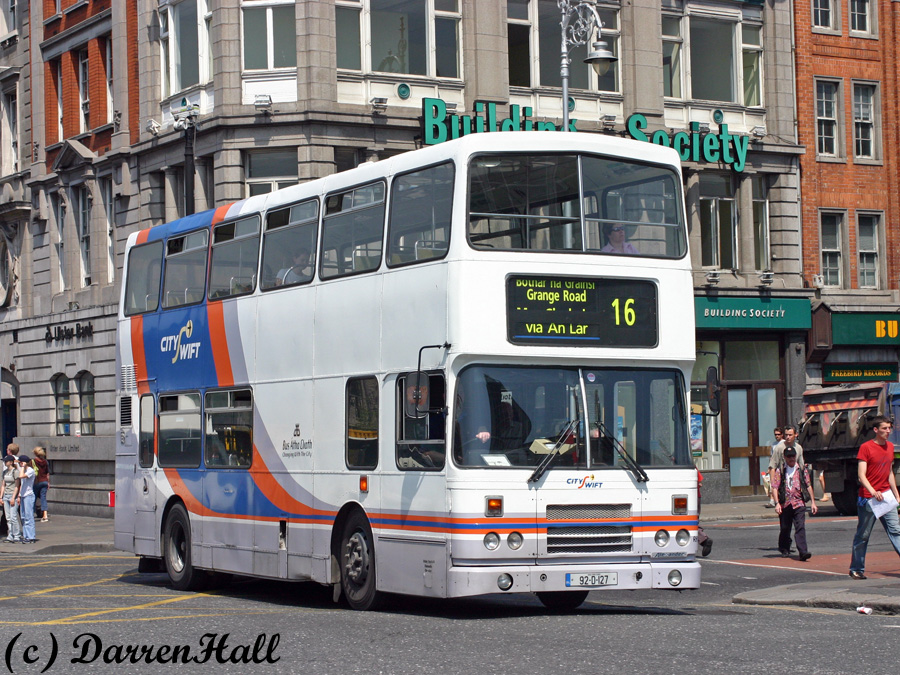
Alexander R-bodied Leyland Olympian, RH127, is seen operating a Route 16 service to Ballinteer on O'Connell Bridge on the 12th July 2005. RH127 was delivered in January 1992. The CitySwift 13 changes of November 1997 saw RH127 painted into CitySwift for use on the new route. It was withdrawn early in 2006 and sold for further service with TM Travel, Chesterfield being re-registered J619 CEV.
Approximately half of the 16 services served the Airport, however they could be either a 16, 16A or 16C service. Therefore, services departing the airport displayed the number of the route which they were to operate, 16 (Grange Road), 16A (Lower Rathfarnham) or 16C (Marley Grange). Services heading northbound displayed 16 Santry or 16A Dublin Airport no matter which terminus they departed from.
At night services operated from Santry to Lower Rathfarnham mostly, with only one or two late services from the airport. In order to save on buses, the ludicrous idea of running all but one or two of the night services to Lower Rathfarnham via Grange Road (Sarah Curran Avenue) was implemented. Buses ran every 20mins during this time.
This timetable proved unsuccessful, and the route suffered real problems with reliability, and a new timetable was issued the following summer. This timetable, along with the 3 became the only ones to have journeys noted in red. All Route 16C departures were indicated as such, a rare exception to the other black and white timetable.
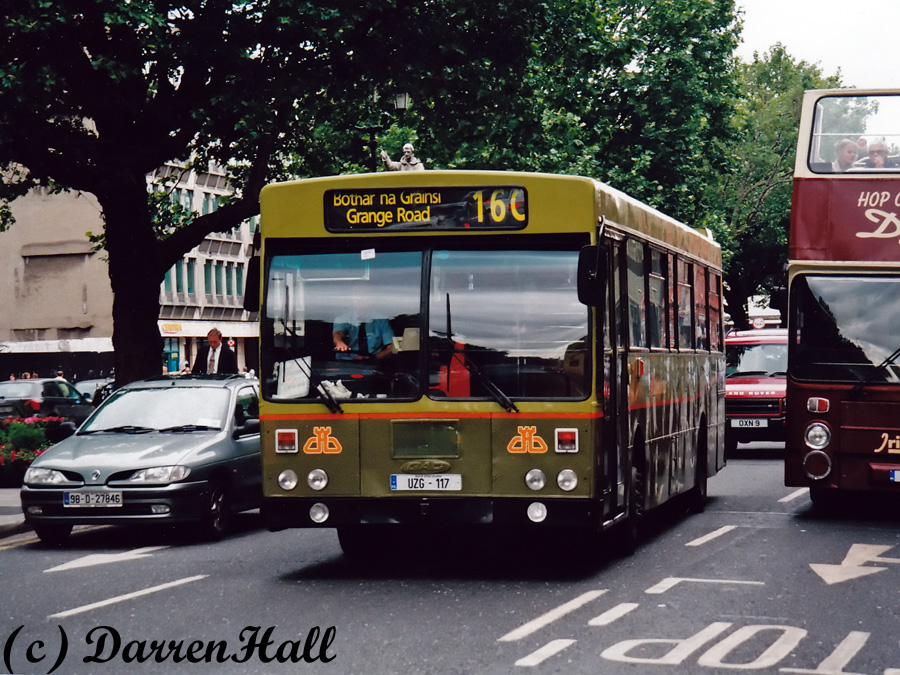
GAC single-dekcer, KC117, is seen on O'Connell Street operating the short lived Route 16C on the 13th July 2000. KC117 entered service with Dublin City Services from Summerhill garage in the Summer of 1985 initially operating Route 17A. However it was used in March 1985 on provincial work from Dublin, mainly on trips to Kildare, Kells and Wicklow. It would join sister vehicles KC116-119 on the Airport service, also bearing the Airlingus Blue, White and Cream livery for a few years. KC117 was interesting in that it was converted from Dual Door as delivered to Single Door as shown above in the photo. It was ousted from the Airport service with the delivery of AD35-40 for the Airlink service. Unlike KC119, noted in the caption above, KC117 did not revert to Dual Door format. Thus when capacity on the Airlink service needed to be increased in the autumn of 1997, KC117 was chosen to gain the then yellow and green Airlink livery and reverted back to the Airport service. The delivery of RV class buses for the Airlink service in 1999, saw KC117 revert back to standard service once again, with another repaint into two tone green. This is interesting in that it must be one of the last repaints of the two-tone green. It was one of the last four KCs operated by Dublin Bus, eventually being withdrawn in December 2000.
On the 13th February 2000 Route 16C services were removed from their Marley Grange terminus, due to safety concerns by Summerhill drivers. They then operated to Ballinteer Avenue only. Buses turned left off the Grange Road onto Stonemason's Way operating nonstop via Broadford Road, Ballinteer Avenue and then setting down on the new Brehon Field Road just before its junction with Grange Road.
In the autumn of 2000, the 16C was instead terminating at the Broadford Road terminus of Route 48A, operating the route as noted above but stopping at stops along the way. Thus a 16C to town served the same stops along Broadford Road as the 48A.
The Rathfarnham QBC was launched on the 21st March 2001 while the Whitehall QBC was launched a few weeks later on the 9th April 2001. Unlike other QBC launches, there was no great increase in route frequencies. In fact the timetable stayed the same. All that was noted was that during peak periods buses would be slotted in along the route. This they said would correspond to a 50% increase in the peak hour service, but like most cases it mostly corresponded to 50% extra buses to cope with the existing timetable in worsening traffic conditions.
A route revision finally happened on the 7th October 2001, when all Route 16 services were extended along the then new Brehon Field Road to Ballinteer (Kingston) replacing Route 16C and the former Sarah Curran Avenue terminus. This also split to operation of the routes, whereas previously buses had previously jumped from route to route throughout the day, i.e. operated from Lower Rathfarnham to the Airport and then operated as a 16 to Grange Road. From then the routes operated as – Route 16 Santry to Ballinteer and Route 16A Airport to Lower Rathfarnham. Journey times were kept the same, and the frequency was very 20mins each and every 10mins combined.
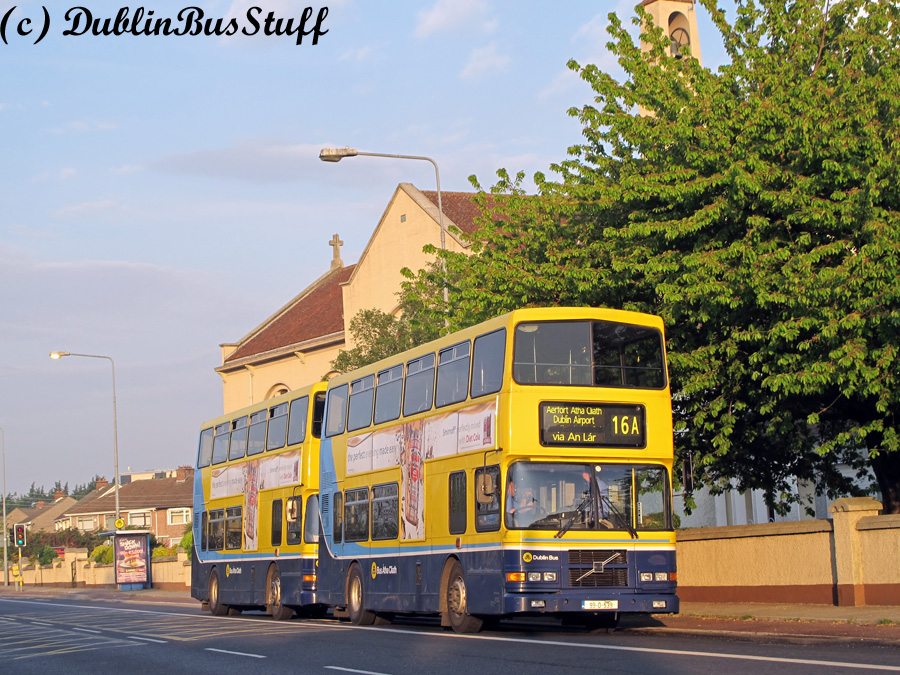
Alexander R-bodied RV539 is seen at the Nutgrove Avenue terminus of Route 16A on the 22nd April 2011. Delivered to Phobsborough in the summer of 1999, RV539 was the second last scrolled RV numerically, RV540 being the last. It moved to Harristown in November 2004, however not before a well known enthusiast had his first day's service with Dublin Bus in it. It moved to Summerhill in late 2008, before moving to Ringsend in August 2011. It was/will be the last scrolled RV in service with Dublin Bus.
The construction of the Port Tunnel in this region, the main site being at the corner of Swords Road and Collins Avenue West, brought a lot more traffic into the Beaumont area. The Celtic Tiger also saw large increases in car traffic. Thus Route 16 services were significantly delayed around the Beaumont loop in the morning peak. Thus from the 7th October 2001, Route 16 and 16A services avoided the Beaumont area during the hours of 0730 and 0900.
Instead a 15min service was introduced that operated from the church carpark on Collins Avenue West, via Beaumont Road and Shantalla Road to the Swords Road and then on route generally to Nutgrove Avenue. Thus buses operating to and from the city shared the same stops during these hours, something which is still the case today. The stop at the church carpark is only used by the these services. It was introduced as a Park & Ride stop during Christmas Operation Freeflows, but is a nice place for these services to layover and await their time.
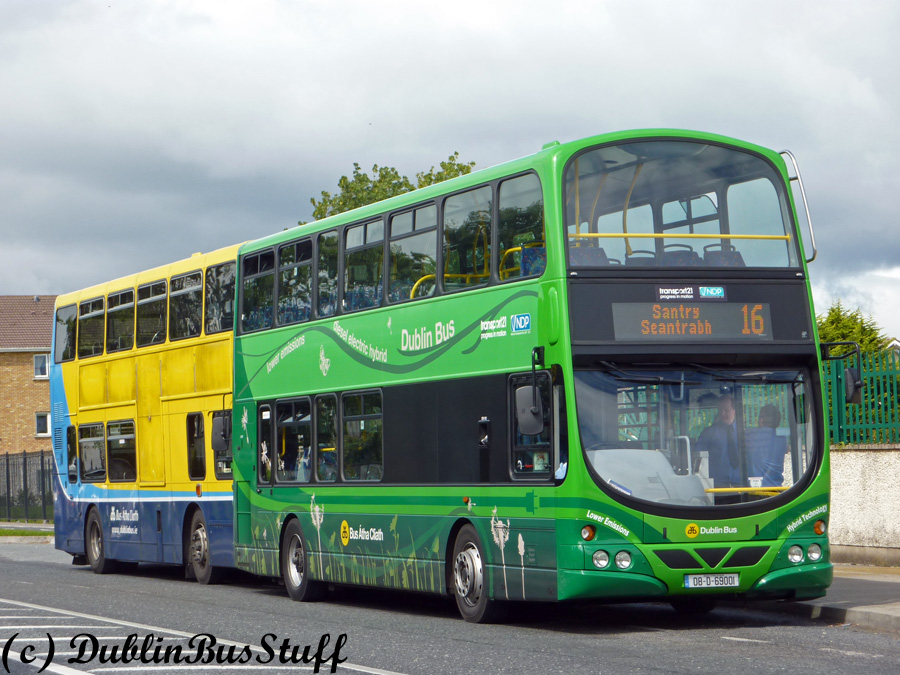
Another photo of WH1, this time at the Ballinteer (Kingston) terminus of Route 16 on the Brehon Field Road on the 5th August 2010. WH1 deserves 2 photos being a bus that spent almost all of its existence in Dublin operating Route 16.
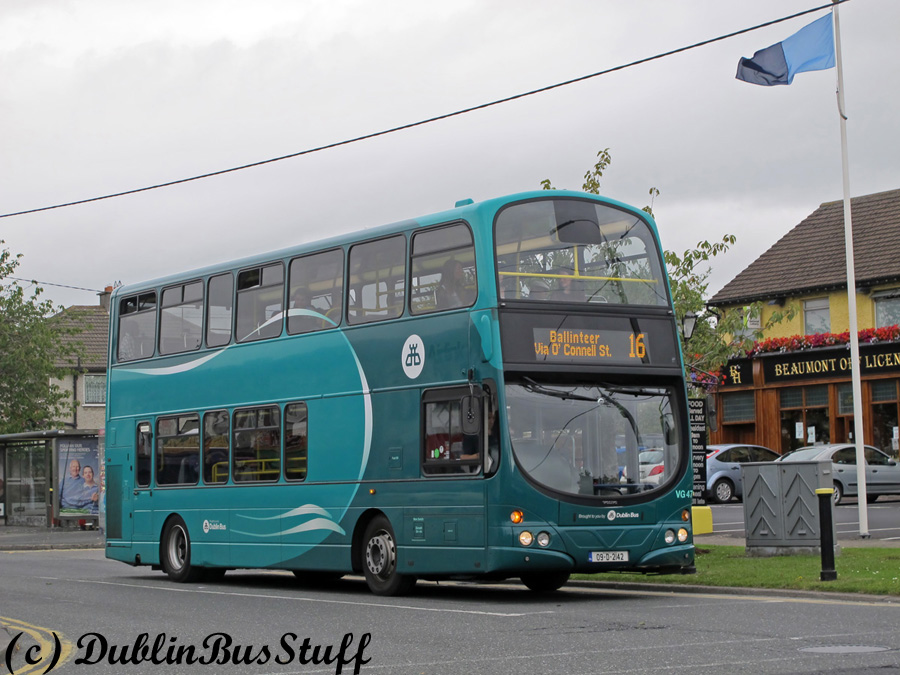
VG47, like VG48 above, is an ex-Airlink decaled bus that presently retains its former Airlink livery and can be found on standard city services as well as helping out on Route 747. It is seen above turning right at the Beaumont House at the corner of the Beaumont Road and Shantalla Road on Route 16 on the 31st July 2011.
New Route 16 and the end of the 16A
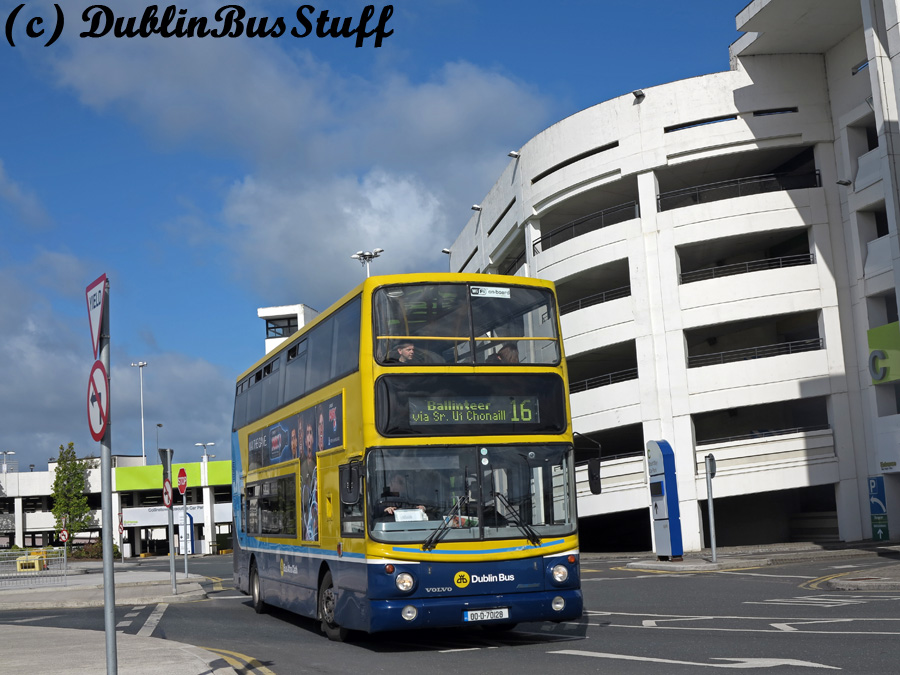
Summerhill's AV128 is seen operating on new Route 16 in Dublin Airport, with the short term parking as the backdrop, on the 14th May 2012.
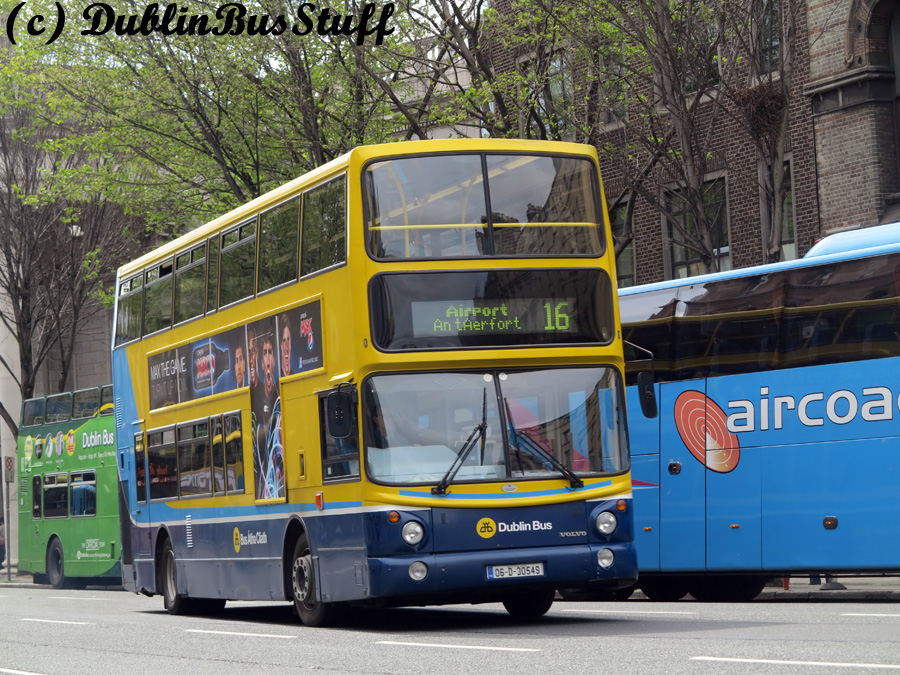
Summerhill's AX549 is seen operating new Route 16 to Dublin Airport on the first day of the new route's operation, the 13th May 2012, on Westmoreland Street.
The 13th May 2012 saw the 16 and the 16A merged into one "Super Route" as part of the Network Direct network reorganisation. The new Route 16 operates from Dublin Airport (the former 16A northside terminus) to Ballinteer (the former 16's southside terminus). A 12min daytime frequency is slightly less than previous, however due to the inconsistent journey times and inconsistent loadings of both Routes, the 16A taking longer due to its higher passenger loadings, the initial concept of integrating the services to a 10min frequency never worked, with the routes mostly operating together along their principle corridors. Thus with buses departing every 12mins from consistent termini the corridors served should see a notable improvement in service.
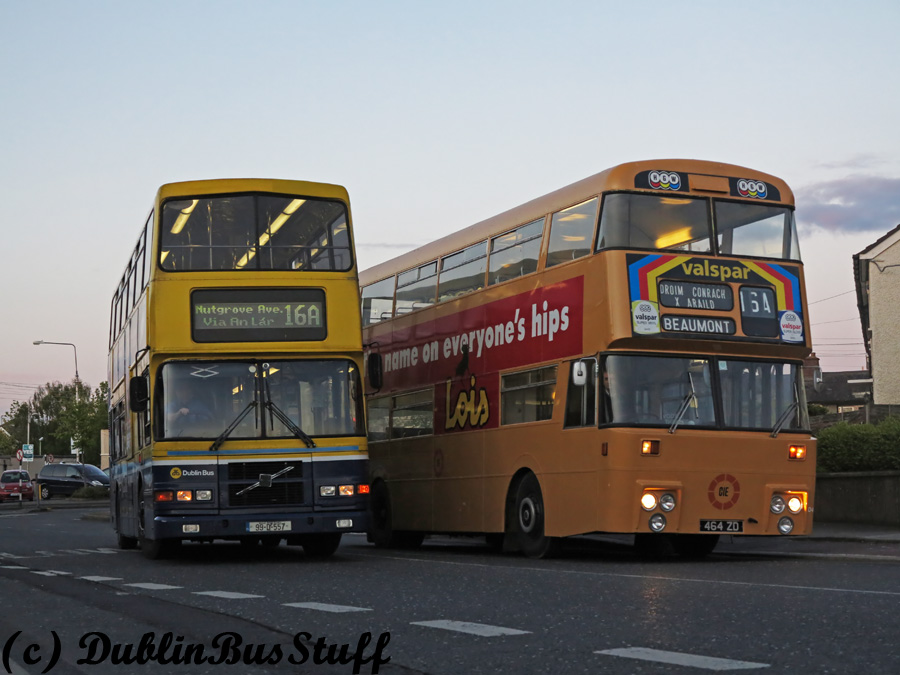
Dusk is falling on Route 16A as RV557 passes preserved D464 at the Route 16A terminus on Nutgrove Avenue, on the evening of 12th May 2012.
However, as noted, one of Dublin's most historic routes has been cut as part of these changes. The number 16A is heavily engraved on this author's memory, and of many in Dublin. The A stood for Airport in everyone's mind, even though this is a more modern extension. It is the people of Nutgrove who lose out principally. Anyone living close to the Bottle tower, has the 14 which offers a quicker route to the city. Those living closer to Rathfarnham Village have the 16. But those inbetween see their service levels drastically cut, with a 61 only every hour, down from the 20min frequency of Route 16A.
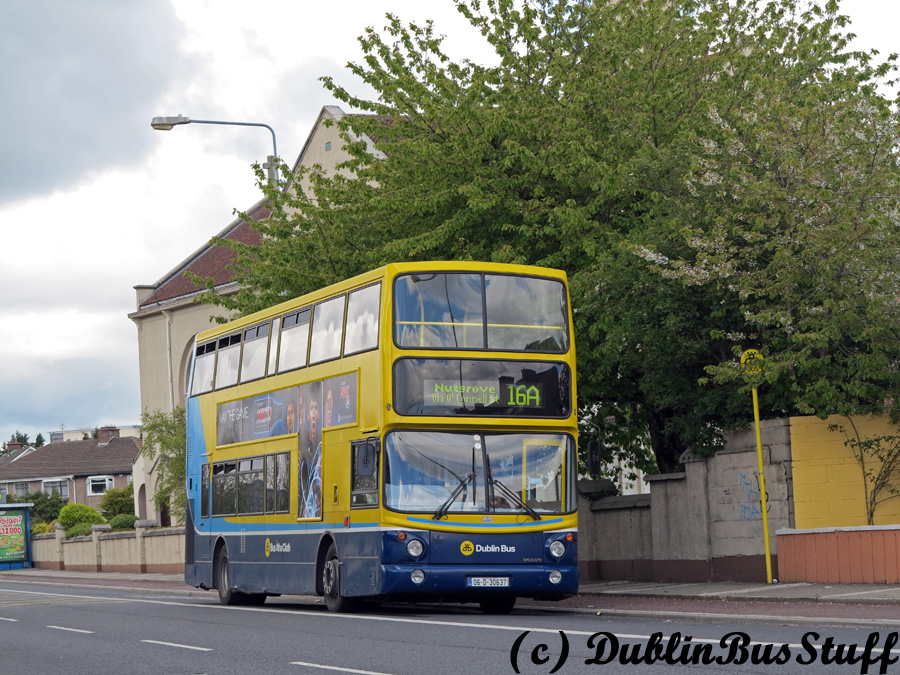
AX637 is seen at the Nutgrove Avenue set down stop of Route 16A on the last day of this route's existence, the 12th May 2012.
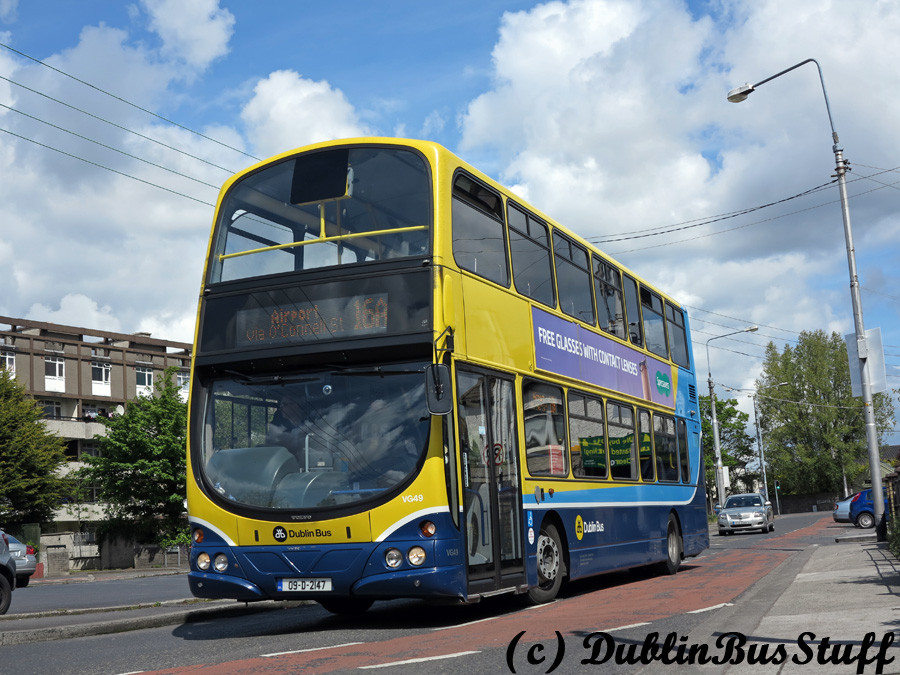
VG49 is seen at the turning circle of Route 16A, a one-way circus formed at the the junction of Nutgrove Avenue and Beaumont Avenue, on the last day of Route 16A, the 12th May 2012.
An interesting, and confusing, aspect to the new 16 is the morning Route 16 service. Though the new route is Dublin Airport to Ballinteer, the first service from Dublin Airport is 0800. From 0600 to 0840, buses depart at 20min intervals from Santry, not serving the Beaumont loop. To fill in the service to every 10mins, a 16 leaves Collins Avenue West also every 20mins between 0710 and 0830, operating the reverse way around the Beaumont loop to Shantalla Flyover before heading down the Swords Road past Whitehall Church towards the city.
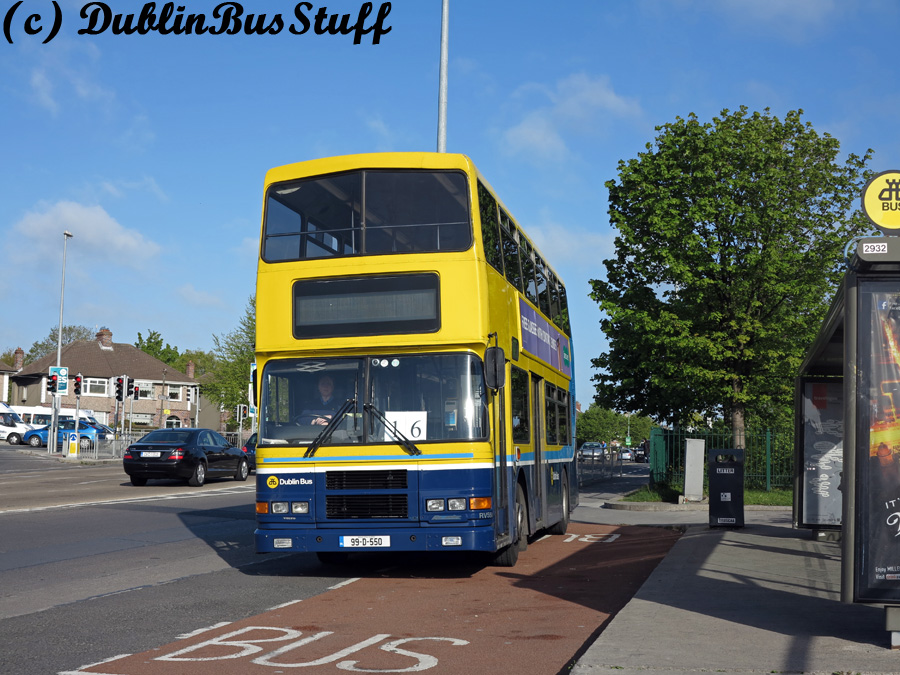
RV550, with an improvised scroll, is seen on the 0830 Collins Avenue West departure of Route 16 on the 14th May 2012. This stop is only used these Route 16 services, and in fact is technically not a pick up stop. The stop's existence dates back to the Operation Freeflows of the mid-90's, where throngs of buses, mainly P's in the early days, would operate from here to the city, performing a U-turn at this very location.
The 0800 takes about 20mins to get to the Beaumont House, so it and the 0830 should meet each other, heading to the same place, yet operating in different directions around the loop. I'm not sure this confusion is necessary, the traffic on the Beaumont Road loop is much less than it was previously, especially with the economic downturn and the completion of the Port Tunnel project. A 10min frequency from Santry around the Beaumont loop would be a better fit in this author's opinion. That said, the best fit in this author's opinion would have been for Route 1 to be the only service along the Shantalla Road, with Route 16 heading direct. Though local residents were against this idea due to their connection to the airport being lost, it is inconceivable to think that all airport services would be directed via a low population area at the cost of all airport passengers. A low frequency replacement, such as the 104 would have been ideal, though this author had great hopes that the northside's most popular ameniety would be better linked with its surrounding areas after Network Direct by such lower frequency services. I may return to said ideas as some point in the future, as an image of the week.
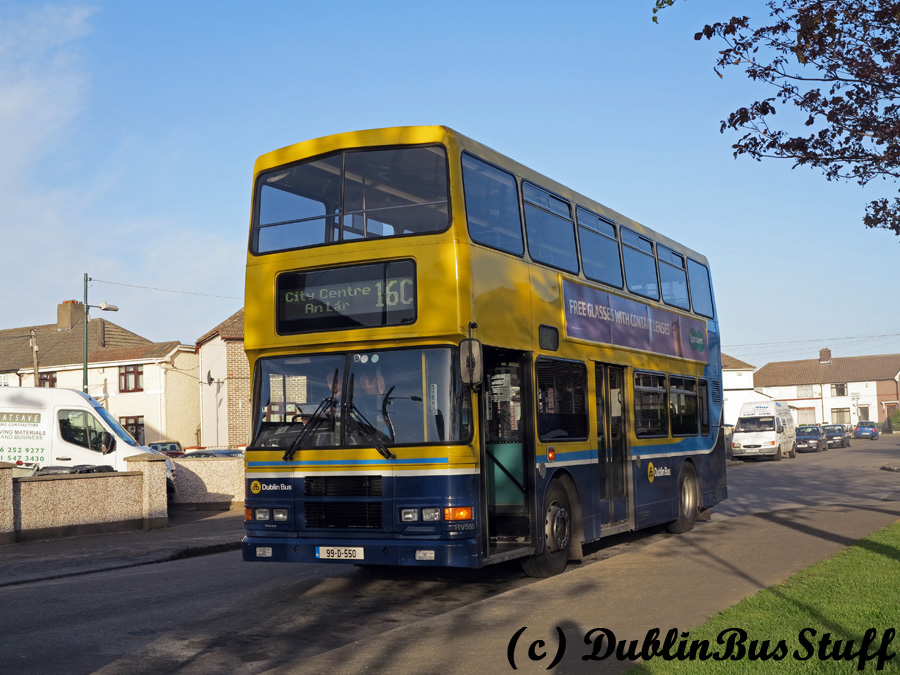
RV550 is seen earlier in the day (then with an operational scroll) operating the first ever 16C (0700 departure) from Larkhill, the first ever 16 bus into Larkhill at the Glendun Road terminus on the 14th May 2012.
Another very interesting developement is the addition of Larkhill departures for Route 16. There are 3 departures, at hourly intervals in the morning peak (at 0700 (16C), 0800 (16) and 0900 (16C)), with 2 operating as Route 16C to the city and the other operating the full route to Ballinteer southbound. These services operate as per the former Route 3 to the city (or as per the new 44). The 44 also departs Larkhill at hourly intervals, and the timetables are interlaced to provide a 30min morning frequency from Larkhill.
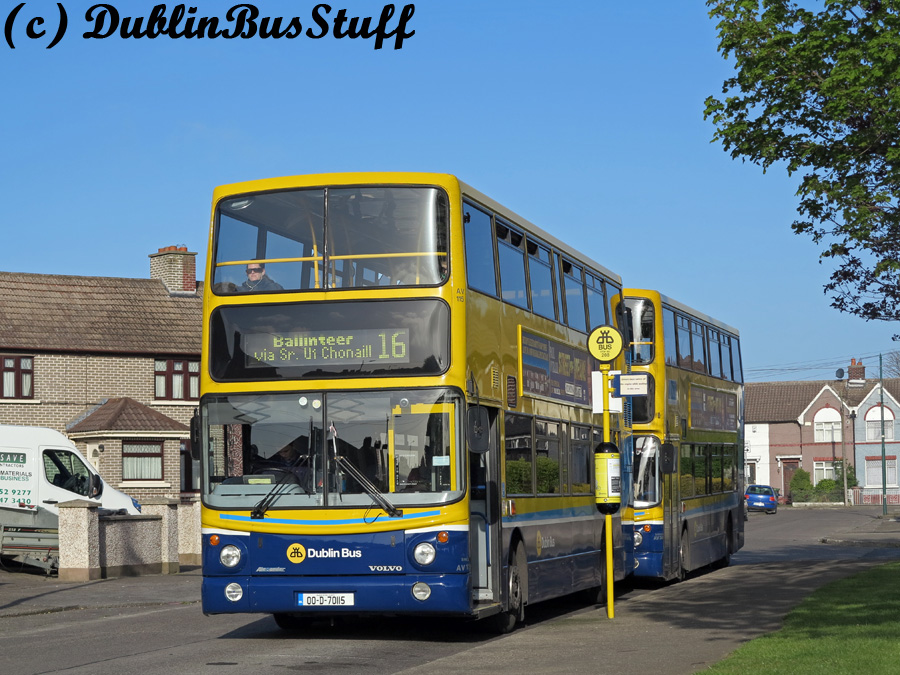
AV115 is seen operating the first ever 16 from Larkhill to Ballinteer on the 14th May 2012. AV349 is seen behind having operated the 0645 Route 44 from Enniskerry.
